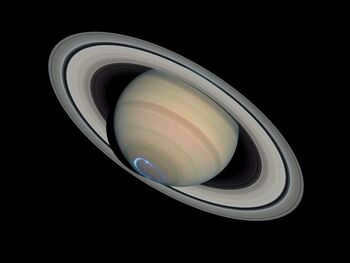

It is the farthest planet from the Sun that can be observed without the aid of instruments, so its existence has been known for a considerable time. Before you is one of the four gas giants, ranking sixth in the solar system.
Curious details about Saturn, the sixth planet from the Sun.
- With its impressive brightness, Saturn can easily be observed with the help of binoculars or a telescope.
- People have been aware of Saturn’s existence since ancient times, with the Babylonians and people of the far east being among the first to observe it. The planet got its name from the Roman titan, which is the equivalent of the Greek god Kronos.
- What makes Saturn unique is its polar diameter, which covers 90% of its equatorial diameter. This phenomenon is due to its low density and rapid rotation. In fact, the planet completes a full rotation around its axis in just 10 hours and 34 minutes.
- The ancient Assyrians gave Saturn the nickname “Lubadshagush,” which means “the oldest of the oldest” in reference to its slow movement in the night sky.
- The upper layers of Saturn’s atmosphere consist of ammonia ice, followed by water clouds, and then a mixture of hydrogen and sulfur in lower regions.
- Researchers have observed a hexagonal shape above the north pole of Saturn, which is believed to be a wave pattern in the upper clouds. Additionally, there is a vortex over the south pole that resembles a hurricane.
- Saturn is divided into layers that become denser as you go deeper. At greater depths, the hydrogen in Saturn’s atmosphere becomes metallic. At the core of Saturn is a glowing interior.
- The rings of Saturn are composed of ice shards and a small amount of carbonaceous dust. They extend for a distance of 120,700 km but are incredibly thin, measuring only 20 meters in thickness.
- Saturn’s moons are icy worlds, with Titan and Rhea being the largest. Enceladus may also have a subsurface ocean.
- Saturn’s composition consists of ice and rock. The frozen surface layer of Saturn has lakes of liquid methane and landscapes covered in frozen nitrogen. There is a possibility that Saturn may harbor life.
Size, mass and orbit of the planet Saturn
Saturn has an average radius of 58232 km (equatorial radius – 60268 km and polar radius – 54364 km), which is 9.13 times the radius of the Earth. It has a mass of 5.6846 × 1026 kg and a surface area of 4.27 × 1010 km2, resulting in a volume of 8.2713 × 1014 km3.
Saturn is located 1.4 billion kilometers from the Sun. The maximum distance it reaches is 1,513,783 km, while the minimum distance is 1,353,600 km.
The average speed of Saturn’s orbit is 9.69 km/s, and it takes 10,759 days for Saturn to complete one orbit around the Sun. This means that one year on Saturn is equivalent to 29.5 Earth years. However, similar to Jupiter, Saturn also experiences differential rotation in different regions. In terms of its shape, Saturn resembles a flattened spheroid.
Saturn’s Orbit and Rotation [ ]
Composition and Surface of the Planet Saturn [ ]
Saturn is a massive gas giant composed mainly of hydrogen and gas. Its average density of 0.687 g/cm³ is surprisingly low, equivalent to the density of water. This means that if Saturn were placed in a massive body of water, it would actually float. Unlike terrestrial planets, Saturn does not have a solid surface. Instead, it has a dense core surrounded by layers of gas. As you move closer to the core, the temperature, density, and pressure increase.
Scientists believe that the structure of Saturn is similar to that of Jupiter. It is thought to have a rocky core surrounded by layers of hydrogen, helium, and other volatile substances. The composition of the core may be similar to that of Earth, but with a higher density due to the presence of metallic hydrogen.
At the core of the planet, the temperature reaches a staggering 11700°C, with the amount of radiated energy being 2.5 times greater than the energy it receives from the Sun. This phenomenon can be attributed to the gradual gravitational contraction known as the Kelvin-Helmholtz process. Another factor contributing to this is the upward movement of helium droplets from the planet’s depths into the hydrogen layer, which generates heat and carries helium away from the outer layers.
According to estimates made in 2004, the core of the planet is believed to be between 9 and 22 times the mass of the Earth and has a diameter of 25,000 kilometers. It is surrounded by a dense layer of liquid metallic hydrogen, followed by a layer of hydrogen saturated with helium. The outermost layer extends for 1,000 kilometers and consists mainly of gas.
Saturn’s Moons: A Celestial Parade
Saturn proudly boasts a stunning collection of 150 satellites, although only 53 of them have been officially named. Out of the named satellites, 34 have diameters smaller than 10 km, while 14 fall between the range of 10 and 50 km. However, the innermost satellites are on a whole different scale, spanning an impressive 250-5000 km.
Many of these satellites draw their names from the ancient Greek mythology, particularly from the tales of the titans. The inner moons, which have relatively small orbital inclinations, are mostly named after titans. On the other hand, the irregular satellites, situated in more distant regions, can orbit Saturn at millions of kilometers away and complete a full revolution in just a few years.
Among the inner satellites, we find Mimas, Enceladus, Tethys, and Dione. These moons are primarily composed of water ice and may also possess a rocky core, icy mantle, and crust. The smallest among them is Mimas, with a diameter of 396 km and a mass of 0.4 x 10 20 kg. Its peculiar egg-like shape and its distance of 185,539 km from Saturn result in an orbital period of 0.9 days.
Significant geysers have been observed in the southern polar region. These powerful water jets play a crucial role in replenishing Ring E and also raise the possibility of the existence of life on Enceladus, as they originate from an underground ocean. Enceladus boasts an impressive albedo of 140%, making it one of the most brilliantly reflective objects in the entire system.
Tefia, the second largest moon of Saturn, measures a diameter of 1066 kilometers. Its surface is predominantly covered with craters, hills, and a few plains. One prominent feature is the Odyssey crater, which stretches an impressive 400 kilometers. Additionally, Tefia is home to a network of canyons that extend 2000 kilometers in length, 3-5 kilometers in depth, and 100 kilometers in width.
Dione, with a diameter of 1112 km and a mass of 11 x 10 20 kg, is the largest moon located within Saturn’s inner region. Over time, its surface has experienced significant damage from numerous impacts, resulting in the formation of craters, some of which are as large as 250 kilometers in diameter. Additionally, there are indications of geologic activity that occurred in the past.
In contrast, the outer satellites of Saturn are situated beyond the E-ring and consist primarily of water ice and rock. One of these satellites, Rhea, has a diameter of 1527 km and a mass of 23 x 10 20 kg. It is positioned 527,108 km away from Saturn and completes an orbit in approximately 4.5 days. Similar to Dione, Rhea’s surface is also marked by craters, and the posterior hemisphere showcases several prominent faults. Notably, two large impact basins with diameters ranging from 400 to 500 km can be observed on Rhea’s surface.
Titan is Saturn’s largest satellite, measuring 5,150 km in diameter and weighing approximately 1.35 x 10^20 kg. It accounts for 96% of the orbital mass around Saturn. What sets Titan apart is its unique atmospheric layer, making it the only major moon with its own atmosphere. This atmosphere is composed of nitrogen and methane, alongside small quantities of hydrocarbons and ice crystals of methane.
Due to the dense atmospheric haze, the surface of Titan is challenging to observe. However, some features are visible, including crater formations, cryo-volcanoes, and longitudinal dunes. Another distinctive characteristic of Titan is the presence of methane-ethane lakes, making it the only celestial body in the system to possess such lakes. Additionally, it is believed that Titan has an underground ocean. In terms of distance, Titan is located approximately 1,221,870 kilometers away from Saturn and takes 16 days to complete one orbit around the planet.
In the vicinity of Titan, you can find Hyperion. With a diameter measuring 270 kilometers, it ranks second in terms of size and mass, just behind Mimas. This peculiar object takes on an ovoid shape and has a surface resembling a sponge, adorned with craters ranging from 2 to 10 kilometers in diameter. Interestingly, Hyperion lacks a predictable rotation.
Now let’s move on to Japet, which extends for about 1470 kilometers and possesses a mass of 1.8 x 10 20 kg. As the most distant moon, it is located at a distance of 3,560,820 kilometers, resulting in a 79-day orbital period. Japet has a fascinating composition, with one side being darker and the other side being lighter. This striking contrast has led to the nicknames “yin” and “yang” for each side.
Finally, we have the irregular satellites, which are characterized by their small size and retrograde orbits. These satellites can be divided into three groups: Inuit, Gaulish, and Norse.
The Inuit have a set of 5 satellites, each named after characters from Inuit mythology. These satellites are Ijirak, Kiviok, Paliak, Siarnak, and Tarkaq. They all have prograde orbits, with distances ranging from 11.1 million km to 17.9 million km. The diameters of these satellites range from 7 km to 40 km, and their orbital inclinations are between 45° and 50°.
On the other hand, we have the Gaul family of satellites, which are located further out. This family includes Albiorix, Befin, Erripo, and Tarvos. The orbits of these satellites are between 16 million km and 19 million km, and their inclination ranges from 35° to -40°. The diameters of the Gaul family satellites vary from 6 km to 32 km, and their eccentricity is 0.53.
Lastly, we have a group of 29 retrograde moons, known as the Scandinavian group. These moons have diameters ranging from 6 km to 18 km, and their distance from the planet is between 12 million km and 24 million km. The inclination of their orbits is between 136° and 175°, and their eccentricity ranges from 0.13 to 0.77. This group is sometimes referred to as the Thebes family, in honor of its largest satellite, which has a diameter of 240 km. Another notable satellite in this group is Imir, which has a diameter of 18 km.
Within the Alcoinid group, which consists of Mephon, Anfa, and Pallene, are situated the moons positioned between Saturn’s inner and outer satellites. These particular moons are the smallest in size. Additionally, some of the larger moons possess their own smaller satellites. For instance, Tephias is accompanied by Telesto and Calypso, while Dione has Helena and Polydevcus.
Information Regarding the Atmosphere and Temperature of Saturn [ ]
Comprising the outer layer of Saturn’s atmosphere is approximately 96.3% molecular hydrogen and 3.25% helium. Although there are also trace amounts of heavier elements, there is limited data regarding their proportions. Propane, ammonia, methane, acetylene, ethane, and phosphine can be found in small quantities. The upper cloud cover is composed of ammonia crystals, while the lower cloud cover consists of ammonium hydrosulfide or water. Ultraviolet radiation induces methylene photolysis, which triggers chemical reactions involving hydrocarbons.
The appearance of the atmosphere is streaked, but the lines become weaker and wider towards the equator. There is a division into upper and lower layers, which differ in composition based on pressure and depth. The upper layers consist of ammonia ice, where the pressure is 0.5-2 bar and the temperature is 100-160 K.
At the level with a pressure of 2.5 bar, a line of ice clouds begins, extending to 9.5 bar and heating up to 185-270 K. Ammonium hydrosulfide bands are mixed in at a pressure of 3-6 bar and a temperature of 290-235 K. The lower layer consists of ammonia in aqueous solution with values of 10-20 bar and temperatures of 270-330 K.
Occasionally, long-period ovals form in the atmosphere, with the most famous one being the Great White Spot. It occurs every Saturnian year at the summer solstice in the northern hemisphere.
Cloud formations on the planet can stretch for thousands of kilometers and have been documented in 1876, 1903, 1933, 1960, and 1990. The “northern electrostatic disturbance” observed by Cassini has been under observation since 2010. If these cloud patterns remain consistent, we can expect to see them again in 2020.
In terms of wind speed, this planet is second only to Neptune. Voyager recorded wind speeds of 500 m/s. At the planet’s north pole, there is a distinctive hexagonal wave, while a powerful jet stream dominates the south pole.
The hexagonal shape was first observed in Voyager images. Its sides span a distance of 13,800 km, which is larger than the diameter of Earth. This structure rotates every 10 hours, 39 minutes, and 24 seconds. The vortex at the south pole was discovered using the Hubble telescope. It features winds reaching speeds of 550 km/h and is comparable in size to our own planet’s storms.
There is a belief that these rings are ancient and could have originated alongside the planet. Two theories exist regarding their formation. One suggests that the rings were once a satellite that collapsed due to its proximity to the planet. Alternatively, the rings may not have been part of a satellite at all, but instead are remnants of the nebular material from which Saturn itself emerged.
The rings are divided into seven distinct sections with gaps between them. The A and B rings are the most dense and have diameters of 14,600 and 25,300 kilometers, respectively. They extend from 92,000 to 117,580 kilometers (B) and 122,170 to 136,775 kilometers (A) from the center of Saturn. Cassini’s section covers a span of 4,700 kilometers.
The C ring is separated from the B ring by a distance of 64 kilometers. The A ring is 17,500 kilometers wide and is detached from the planet at a distance of 74,658 to 92,000 kilometers. Together with the A and B rings, it contains the main rings with larger particles. Following these are the dusty rings, which consist of smaller particles.
D spans 7500 km and reaches from 66900 to 75510 km inward. On the opposite side, there are G (9000 km and 166000-175000 km away) and E (300000 km and 166000-480000 km away). F is positioned on the outer boundary of A and is more challenging to classify. It primarily consists of dust. Its width ranges from 30 to 500 km, and it extends 140180 km from the center.
History of Saturn’s Study throughout the Ages
The exploration of Saturn dates back to ancient times when it could be observed without the aid of sophisticated instruments. References to the planet can be found in various legends and mythologies. The Babylonians were among the first to document its existence, associating it with the zodiac.
The ancient Greeks referred to Saturn as Kronos, the god of agriculture and the youngest among the titans. Ptolemy, an influential astronomer, calculated the planet’s orbital passage during opposition. The Romans adopted the Greek tradition and assigned it the name Saturn, which it carries to this day.
In ancient Hebrew, Saturn was known as Shabbatai, while in the Ottoman Empire it was referred to as Zuhal. The Hindus worshiped Saturn as Shani, the judge who evaluates good and bad deeds. The Chinese and Japanese regarded it as the earth star, representing one of the fundamental elements.
However, it wasn’t until 1610 that the planet was first observed by Galileo through his telescope, where he made the groundbreaking discovery of its rings. At the time, Galileo mistakenly believed that these rings were actually two satellites. It wasn’t until later, when Christian Huygens corrected this error, that it was understood that the rings were a distinct feature of the planet. Additionally, Huygens also discovered the moon Titan, while Giovanni Cassini made several other moon discoveries, including Japetus, Rhea, Tethys, and Dione.
Another significant development came in 1789 when William Herschel identified the moons Mimas and Enceladus. Then, in 1848, the moon Hyperion was added to the list of known Saturnian moons.
Further discoveries continued into the 19th century. In 1899, William Pickering made the discovery of the moon Thebe, noting its irregular orbit and synchronous rotation with the planet. It wasn’t until the 20th century that it was realized that Titan possessed a dense atmosphere, a characteristic that had never been observed before.
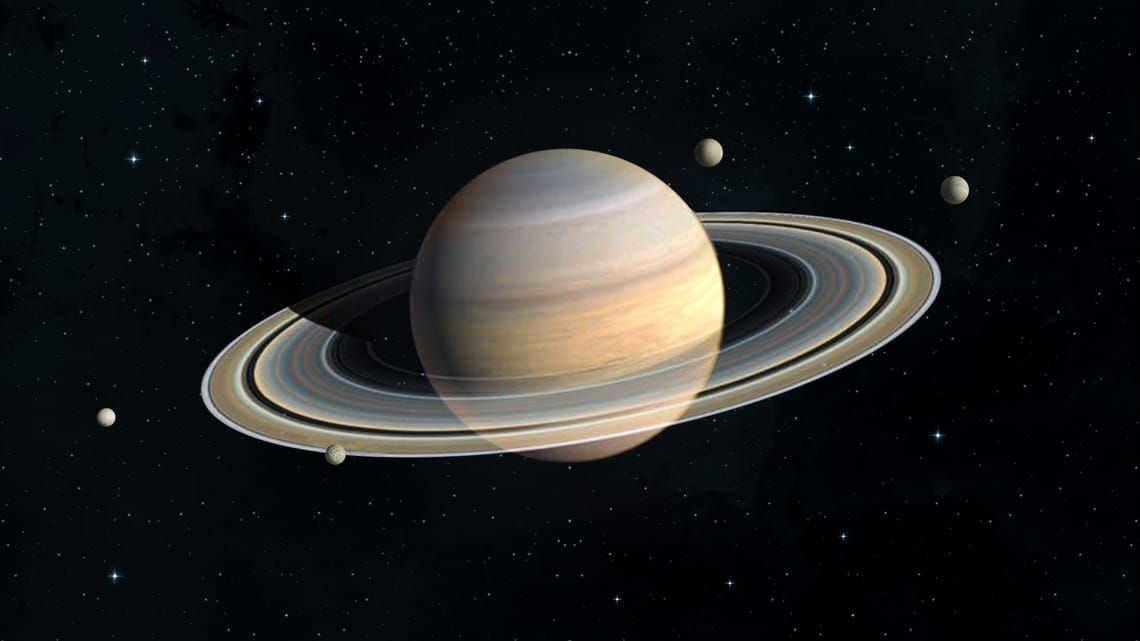
Saturn, the gas giant, is the second largest planet and the sixth planet in the Solar System, located at a significant distance. It is remarkable that Saturn is the most distant planet visible to the naked eye, and its existence has been known since ancient times.
Exploration Background
The first mention of Saturn in literature dates back to 1752 when Voltaire wrote about it. However, the scientific records of Saturn date back even further to 700 BC. During that period, the Assyrians observed a bright, ringed object in the night sky and gave it the name “Star Niniba.”
In 400 B.C., ancient Greek scientists mistakenly identified Saturn as a wandering star and named it after Kronos, the god of agriculture. Later, the Romans adopted the name Saturn, which remains in use today.
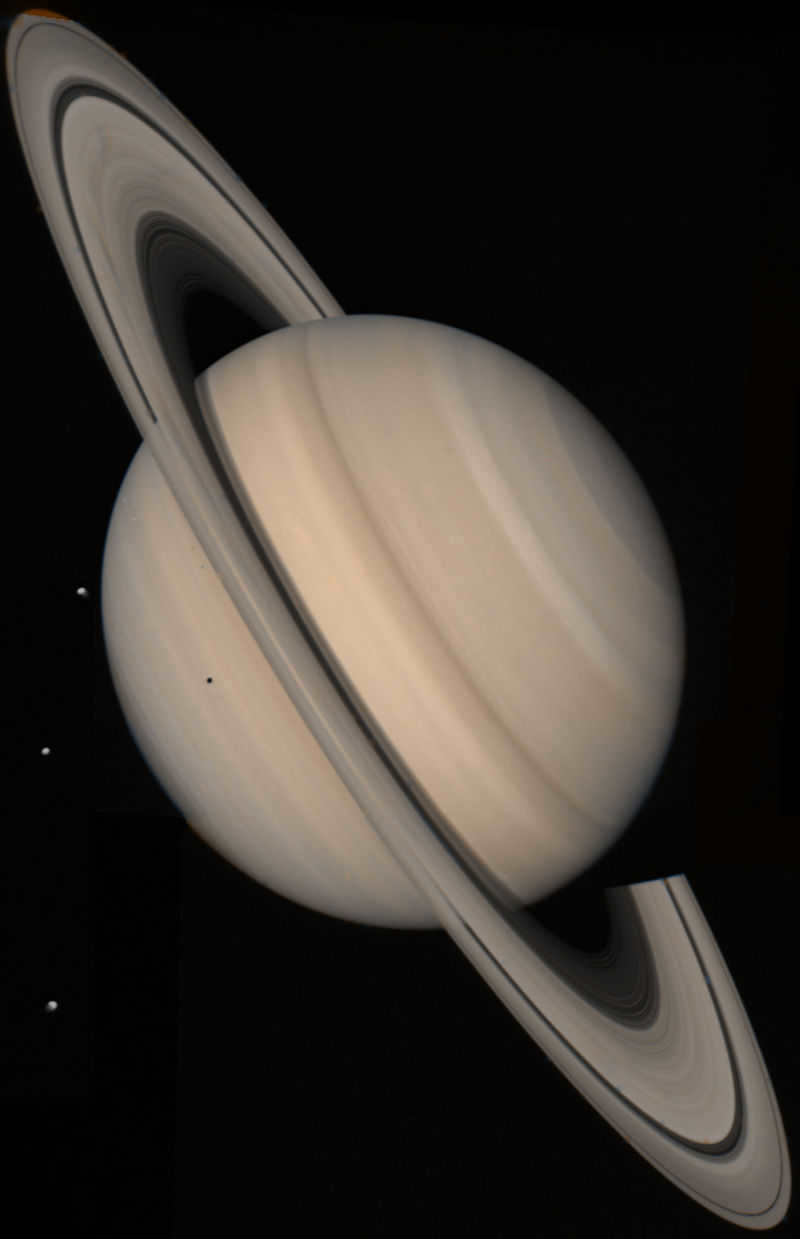

The presence of rings encircling Saturn was initially observed by Galileo Galilei, who mistakenly believed that he had discovered a triple planet. The largest moon of Saturn, Titan, was later identified by Christiaan Huygens in 1666, who also made note of the planet’s ring system.
The existence of gaps between rings A and B was later documented by Jean Dominic Cassini in 1675. Cassini also made significant contributions to the discovery of several other satellites of Saturn, including Dione, Japetus, Rhea, and Tephia.
During the late 18th century, English astronomer William Herschel made the discovery of two additional major satellites of Saturn, namely Enceladus and Mimas. Subsequently, the irregular satellite known as Hyperion and the retrograde-rotating satellite named Theba were also identified.
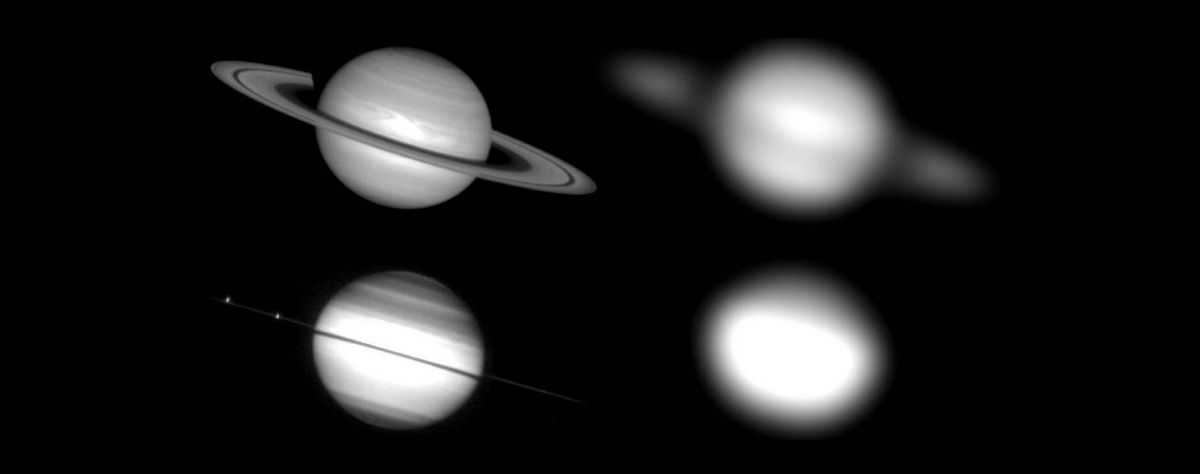
In 1980, further research was conducted by the Voyager spacecraft. It captured four high-resolution photographs of Saturn’s surface, along with its rings and moons. The Voyager 2 mission in 1981 provided even more comprehensive imagery. These images revealed the presence of previously undiscovered moons among Saturn’s satellites.
The year 2004 saw the launch of the Cassini probe, which marked a significant milestone in the exploration of Saturn. Cassini successfully entered the planet’s orbit and conducted a close flyby of its moon, Titan. Additionally, the Huygens probe gathered intricate data about Saturn’s atmosphere and surface.
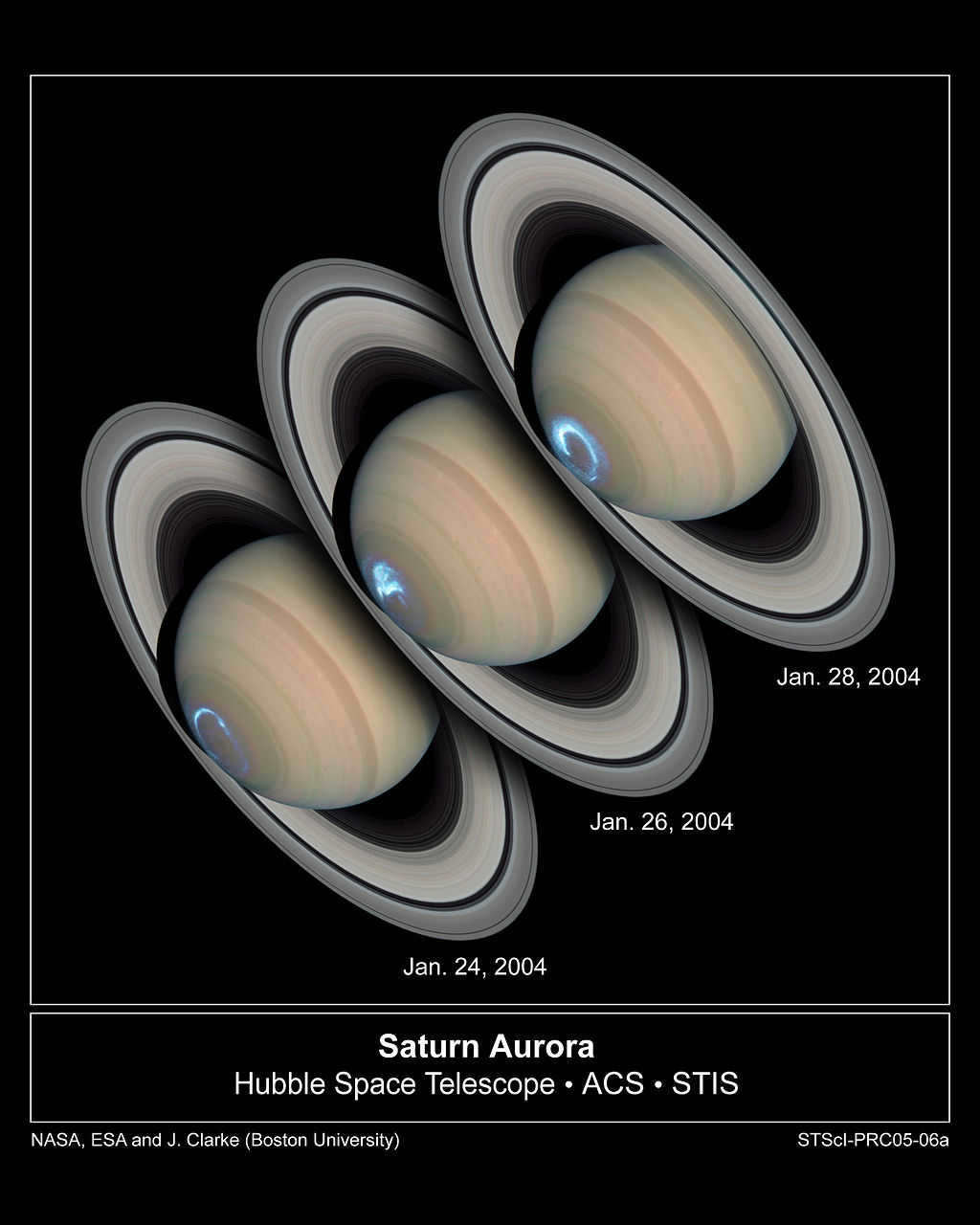

In 2006, the spacecraft made a discovery of preserved liquid water reservoirs in geysers found on the moon Enzland. Subsequently, more than 100 additional geysers were identified by scientists. The images also revealed the presence of a newly observed ring, 8 newly discovered satellites, as well as seas and oceans on the moon Titan.
On January 14, 2015, the Huygens probe achieved a successful landing on the surface of Titan. During its descent of 27 minutes, it extensively studied the atmospheric layer of the moon. For a duration of 1 hour and 10 minutes, Huygens transmitted data from its muddy surface.
The initial plans of the scientists included the continuation of the Cassini mission until 2008. However, it was later extended until 2017.
On the 26th of April, Cassini started its most recent mission, conducting over 20 flybys between the inner ring and the planet itself, capturing the first close-up photos. On the 15th of September, the spacecraft descended into Saturn’s atmosphere and lost all contact with Earth.
This fate was not accidental for the spacecraft: it was crucial to prevent contamination of Saturn’s satellites, which, according to research data, could potentially be inhabited. The spacecraft had a remarkable 20-year service record, completing numerous orbits around the planet and gathering an extensive amount of unique information about the Saturn system.
Geographical Position and Dimensions
Saturn is positioned as the sixth planet in our solar system, with Jupiter preceding it as the fifth planet and Uranus following it as the seventh planet. In terms of average distance, Saturn is located approximately 1.4 billion km away from the Sun. As it completes its orbit around the star, the gas giant’s maximum distance from the Sun extends to approximately 1,513,783,000 km, while its minimum distance decreases to approximately -1,353,500,000 km.


Saturn boasts an impressive magnitude. The planet’s equatorial diameter measures 120,536 km, while its polar diameter spans 108,728 km. Covering a surface area of 4.27 * 10'10 square kilometers and containing a volume of 8.27 * 10'14 cubic kilometers, Saturn’s size surpasses that of Earth by a factor of 9.3 in radius, 82 in area, 765 in volume, and 95 in mass.
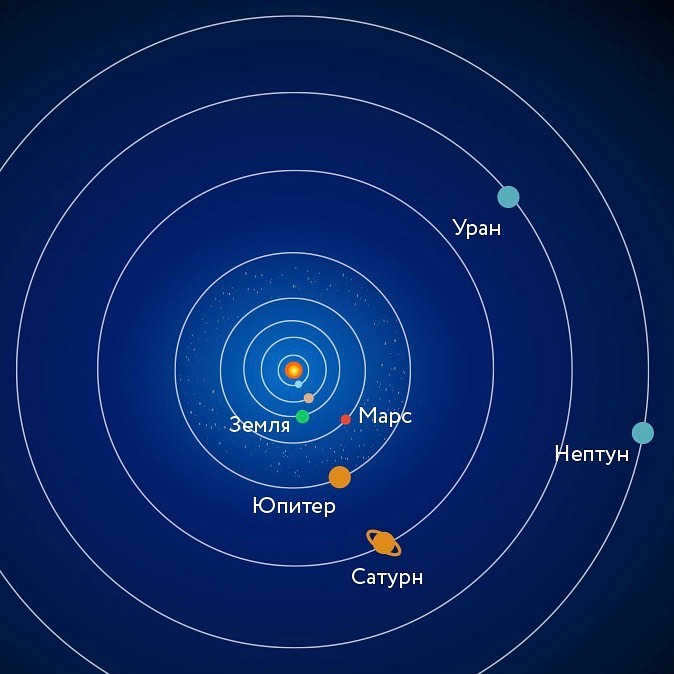
The elliptical shape of Saturn’s orbit causes the planet to approach the Sun at a distance of 1.35 billion km and move away from it by 1.509 km.
Saturn’s orbital inclination is 2.48 degrees relative to the ecliptic, while its axial inclination is 26.73 degrees. These values are similar to those of Earth, resulting in Saturn experiencing changes in seasons.
With a rotation speed of 9.69 km/s, Saturn’s rotation can vary depending on its position in space. It takes the planet approximately 29.457 years to complete one orbit around the Sun.
The rotation of Saturn’s axis takes place in 10 hours and 33 minutes, resulting in a year on the planet lasting 10,759 days, which is 29.5 times longer than a year on Earth.
Composition and Appearance
Saturn’s composition consists primarily of gas layers. Closer to the planet’s core, hydrogen takes on a metallic form, while the middle of the planet contains a red-hot substance. The average density of Saturn is 0.687 g/cm. If Saturn were placed in a body of water, it would not sink.
Unlike Earth, Saturn does not have a solid surface. Therefore, any individual from the terrestrial world who attempts to walk on the planet would be in danger of falling to their death due to the high pressure and extreme temperatures.
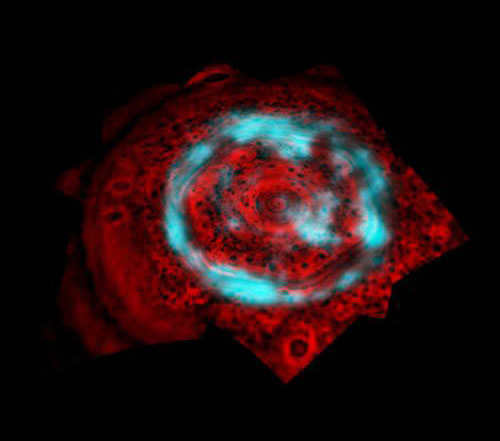

The northern lights over Saturn’s polar region. The auroras are blue in color and the clouds beneath them are red. Just below the auroras, the hexagonal cloud that was previously discovered can be observed.
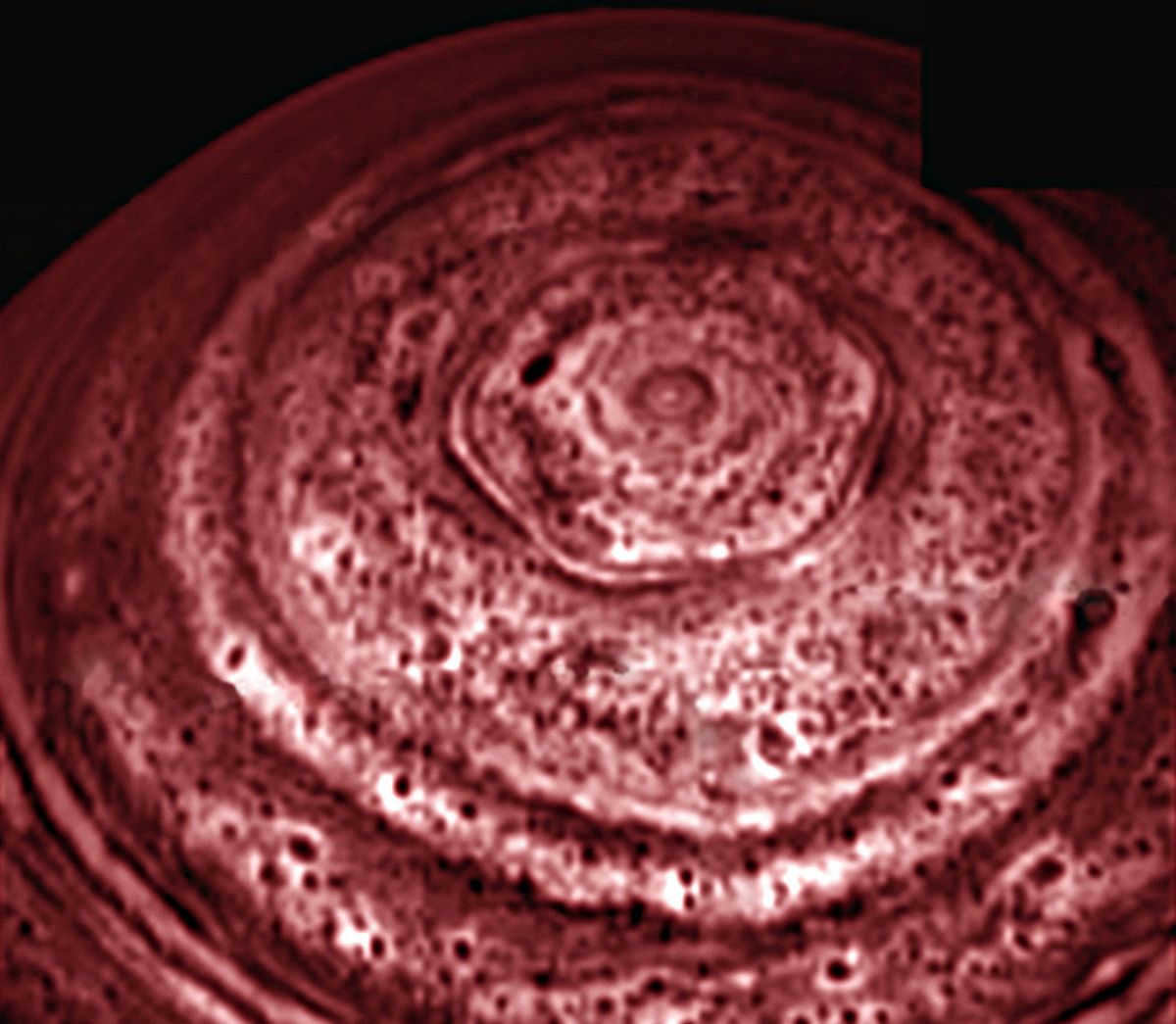

The outer layer of the surface consists of 93% molecular hydrogen and 6% helium. The remaining percentage is made up of ammonia, methane, acetylene, and other impurities. These impurities contribute to the formation of clouds and bands that are visible on the planet.
The troposphere of Saturn is divided into three distinct zones, each with its own temperature regime. These zones play a crucial role in the formation of weather on the planet.
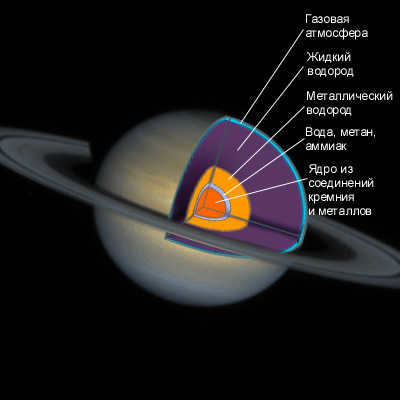
Layers of Saturn:
- The visible part of Saturn is composed of ammonia clouds and is located 100 km below.
- Below the ammonia clouds is a layer of sulfur sulfides.
- Beneath the sulfur sulfides are zero-temperature clouds.
Although standing on the surface of Saturn is not possible, if it were, a person would experience 91% of Earth’s gravity.
This means that a person weighing 100 kg on Earth would have a body mass of 91 kg on the surface of Saturn.
Scientists believe that Saturn has a similar structure to Jupiter, with a rocky core surrounded by hydrogen and helium mixed with volatiles. The core of Saturn is dense, with increasing heat, density, and pressure as you get closer to it.


The inner core of Saturn shares similarities in composition with Earth, but it possesses a greater density due to its abundance of metallic hydrogen. Scientists estimate that the core of Saturn is approximately 9 to 22 times larger than Earth, boasting a diameter of about 25,000 kilometers. Enveloping the core is a dense layer of liquid hydrogen.
Saturn’s rings consist of countless tiny particles that orbit the planet within its equatorial plane. These particles range in size from micrometers to centimeters, primarily composed of ice rather than traditional dust and small stones. Among these particles, there are also larger stones measuring several meters in size, as well as blocks that span tens of meters in length.
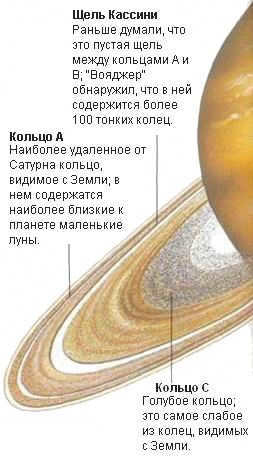

The rings of Saturn are incredibly wide. The outer edge of the last ring, known as the E ring, is located 480,000 km away from the planet’s center, with a width of 300,000 km. However, there are even wider rings that are so sparse they are barely noticeable.
One such example is the Phebe ring, which was discovered in 2009 and has a diameter of 13 million kilometers! Despite their massive size, these rings are relatively thin, ranging from a few meters to a kilometer in thickness. As a result, they are quite transparent, allowing the stars to shine through them.
There are various empty spaces of different widths located between the individual rings, each with its own designated name such as the Enke division, the Cassini gap, and others. These gaps contain a significantly lower number of particles.
Characteristics of the Atmosphere and Temperature
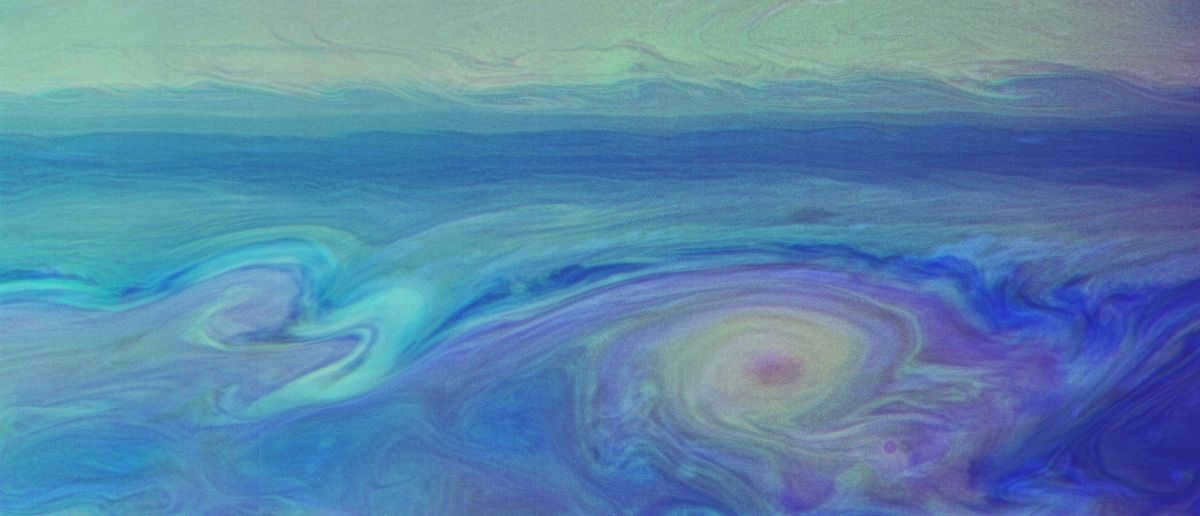
Hydrogen makes up the majority of Saturn’s upper layer, accounting for 96.3%. Helium accounts for 3.25%, while a mixture of other substances such as phosphine, ethane, acetylene, ammonia, methane, and propane occupies 0.45%.
Saturn’s surface is covered by a layer of clouds, which can be divided into upper and lower levels. The upper level is composed of ammonia crystals, while the lower level consists of a mixture of water and ammonium hydrosulfide. These clouds are exposed to ultraviolet rays, which trigger the process of methane photolysis and initiate hydrocarbon chemical reactions.
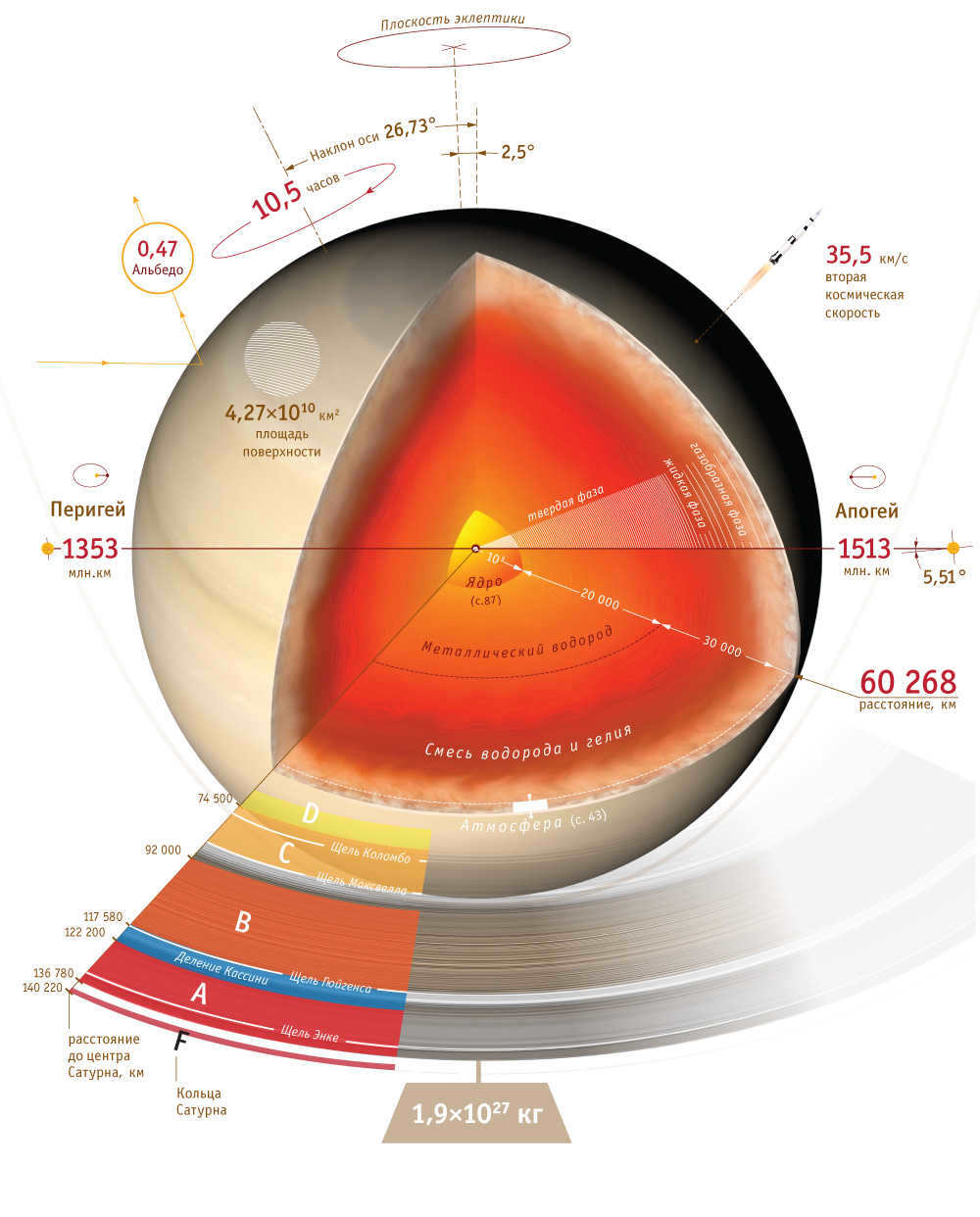
Saturn’s atmosphere is characterized by widening lines as it approaches the equator. It can be categorized into two distinct layers. The upper layer experiences pressure ranging from 0.5 to 2 bar and temperatures that range from -173 to -113 degrees Celsius.
The lower layer, on the other hand, has pressure between 10 and 20 bar and temperatures ranging from -3 to 57 degrees Celsius. Between these layers lies a layer composed of ice clouds, where there is a gradual transition in temperature and pressure.
Occasionally, oval patches form within the atmosphere, which appear whiter than the surrounding clouds, making them easily distinguishable on the surface. The nature of these patches is still unknown to scientists, although observations have revealed a pattern in their formation.
There is a theory that the formation of white spots is connected with disturbances in electrostatics. On the surface of Saturn, there are strong winds that can reach speeds of up to 500 m/s. This is the second highest wind speed in the solar system, second only to Neptune. In the northern region of the planet, there are flow patterns that have a wave-like structure, while in the southern region there are jet streams.
Temperature readings on Saturn vary greatly. From the uppermost layer of the gas planet to its core, there is a significant difference in heating:
- At the outermost layer, where ammonia-rich ice clouds are present, the surface temperature of Saturn is the lowest, ranging from -173 to -177 degrees Celsius.
- In the following layer of the atmosphere, there is a combination of hydrosulfide ice and ammonium. The pressure distribution within this layer varies, resulting in a significant temperature difference: from -3 degrees in the denser areas to -93 degrees in the more sparse regions.
- The layer closest to the surface experiences the highest pressure, similar to the depths of the deep ocean. In this layer, the dense gas mixture is heated to +83 degrees.
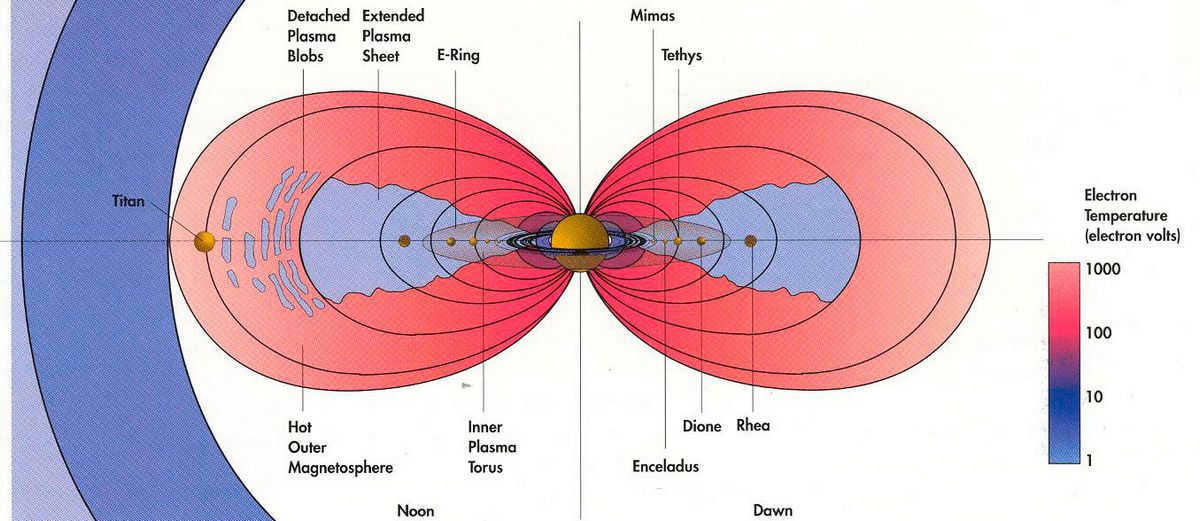

Saturn contains regions with a pleasant temperature of +21 degrees, which is suitable for humans, although the atmospheric pressure is ten times higher than that of Earth. The core of the planet is believed to be extremely hot, reaching temperatures up to +11800 degrees.
Saturn experiences periodic storms, some of which can surpass the size of planet Earth. A notable example is a massive hexagonal storm observed in the southern hemisphere by the Hubble telescope. This storm had a radius of 6,900 km and completed a full rotation in 10 hours and 39 minutes.
The rings of Saturn
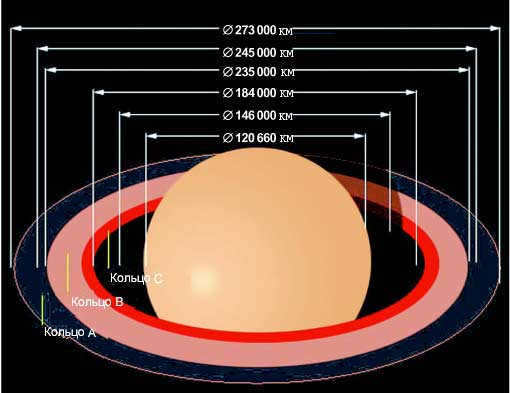
Saturn’s rings are distinctive features that surround the planet. In fact, similar formations can be found around the other giant planets, such as Jupiter, Uranus, and Neptune.
However, unlike Saturn’s rings, the rings of these other planets are much fainter and cannot be observed from Earth. They were only discovered when space probes approached them closely.
Currently, Saturn has a total of seven rings, each varying in width. These rings are named D, C, B, A, F, G, and E, with E being the only one that cannot be seen from Earth. This is because it is too sparse and was only detected by probes.
Amateur telescopes can clearly observe rings C, B, and A, which are arranged in that order from the center of the planet. Between rings B and A lies the Cassini gap, a significant gap that is also visible through amateur telescopes.
There have been numerous hypotheses regarding the genesis of Saturn’s rings, but the most recent and plausible one appears to be as follows. It posits that the rings were created through Saturn’s assimilation of its massive moons.
During the initial stages of planet formation approximately 4.5 billion years ago, Saturn possessed multiple sizable moons, each surpassing the Moon in size. Over time, these moons drew closer to the planet, eventually disintegrating and causing their dense mineral fragments to descend onto the planet’s surface.
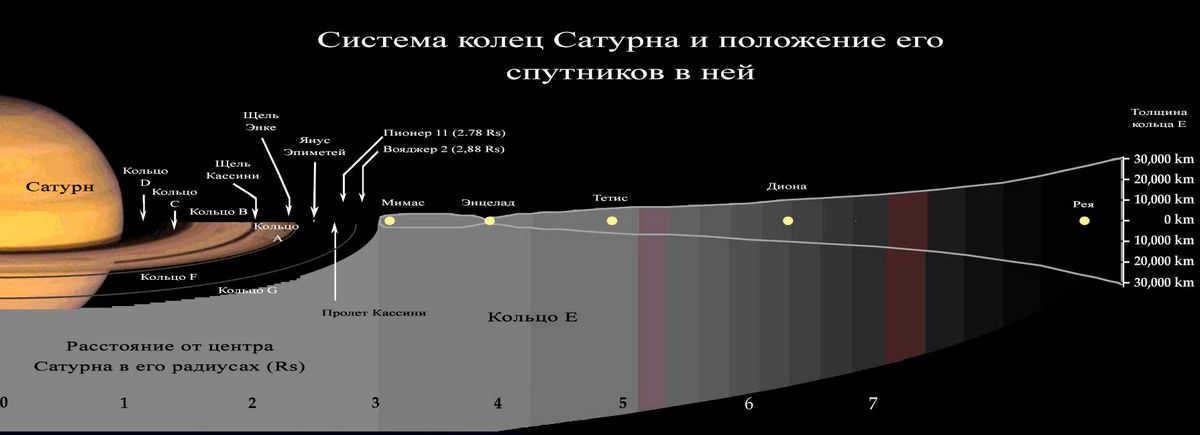

However, a significant portion of their smaller components, primarily originating from the icy shell, remained in orbit. Initially, their sizes varied from 1 to 50 kilometers. As a result of numerous collisions, they progressively fragmented and transformed into fine ice dust, which accumulated in the form of a disk encircling the planet.
The initial mass of Saturn’s rings exceeded today’s by a factor of 1000. Over time, the planet has absorbed a significant portion of the material, which continuously settles into its atmosphere. Throughout billions of years, numerous asteroids and comets have passed by, carrying away substantial amounts of matter. Some of them have even fallen victim to Saturn, being captured and crushed into fine dust.
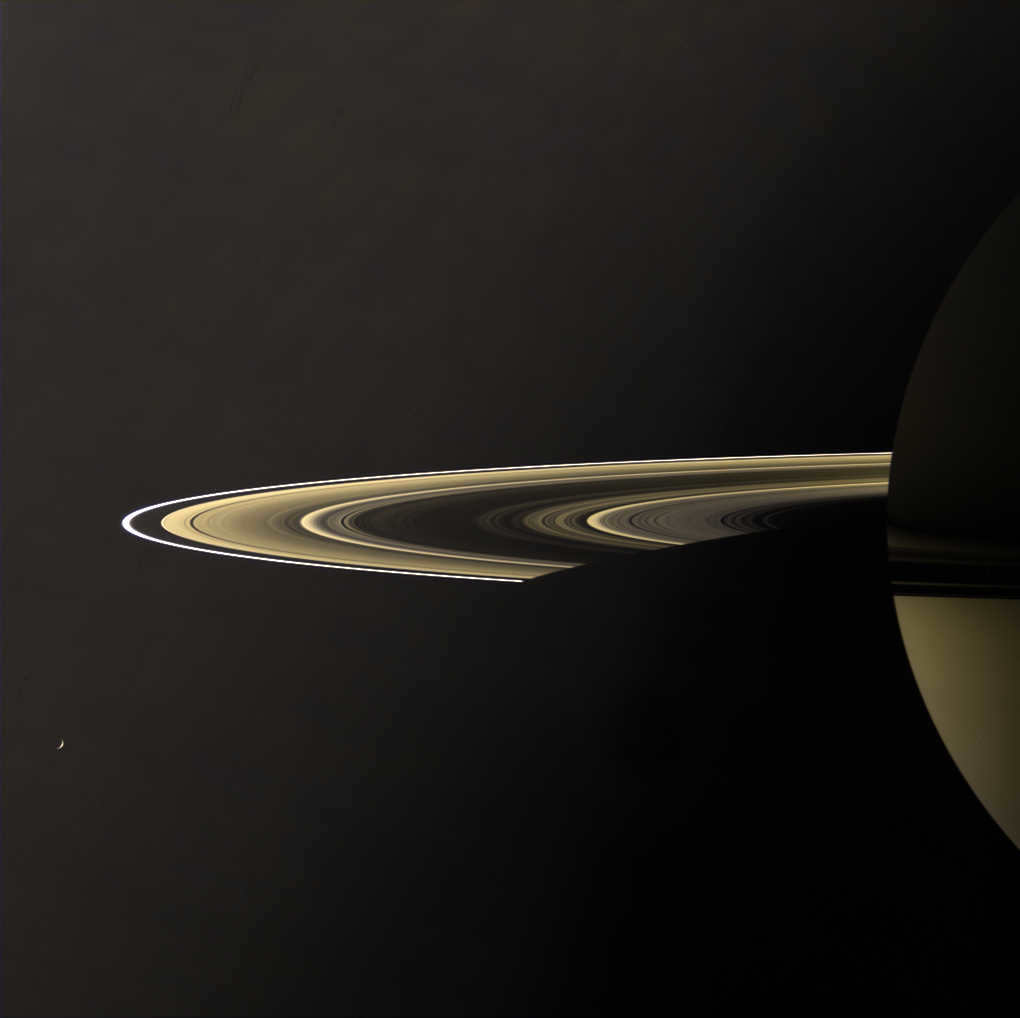

Ongoing research is being conducted on the intricate rings of Saturn. In the year 2006, scientists made the significant discovery that the outer E ring is the result of the satellite Enceladus orbiting within it.
Enceladus is home to a fascinating phenomenon known as ice geysers, where water is expelled from its interior through cracks in its crust. These geysers can reach staggering heights of up to 500 kilometers, expelling 250 kilograms of water vapor every second. The vapor condenses into ice dust, leaving a visible trace within Enceladus’ orbit.
Artificial Satellites
Satellites are objects that orbit around larger celestial bodies, such as planets or moons. They can be either natural or artificial. Natural satellites are celestial bodies that occur naturally, such as Earth’s moon. Artificial satellites, on the other hand, are man-made objects that are launched into space and placed into orbit around a celestial body. They serve a variety of purposes, including communication, weather tracking, scientific research, and navigation. Artificial satellites have become an integral part of modern life, enabling global communication, weather forecasting, and satellite navigation systems. They are launched into space using rockets and are carefully placed into specific orbits to ensure their proper functioning. Satellites can be either geostationary or polar orbiting, depending on their intended purpose. Geostationary satellites orbit at the same rate as the Earth’s rotation, allowing them to remain stationary relative to a specific point on the planet’s surface. This makes them ideal for communication purposes, as they can provide continuous coverage over a specific area. Polar orbiting satellites, on the other hand, travel in a north-south direction and pass over the Earth’s poles. They are used for a variety of purposes, including weather tracking and scientific research. Satellites have revolutionized our understanding of the world and our ability to communicate and navigate. They provide valuable data and images that help scientists study and monitor our planet, as well as improve our daily lives through various applications and services.

A total of 62 satellites of Saturn have been discovered by scientists. Out of these, 53 have been named while the remaining ones have alphanumeric designations. These satellites can be divided into two categories: regular and irregular. The first category includes both inner and outer objects, while the second category consists of objects with irregular orbits. Thebes falls into the latter category as it orbits in the opposite direction to the planetary motion.
Recreatorus,
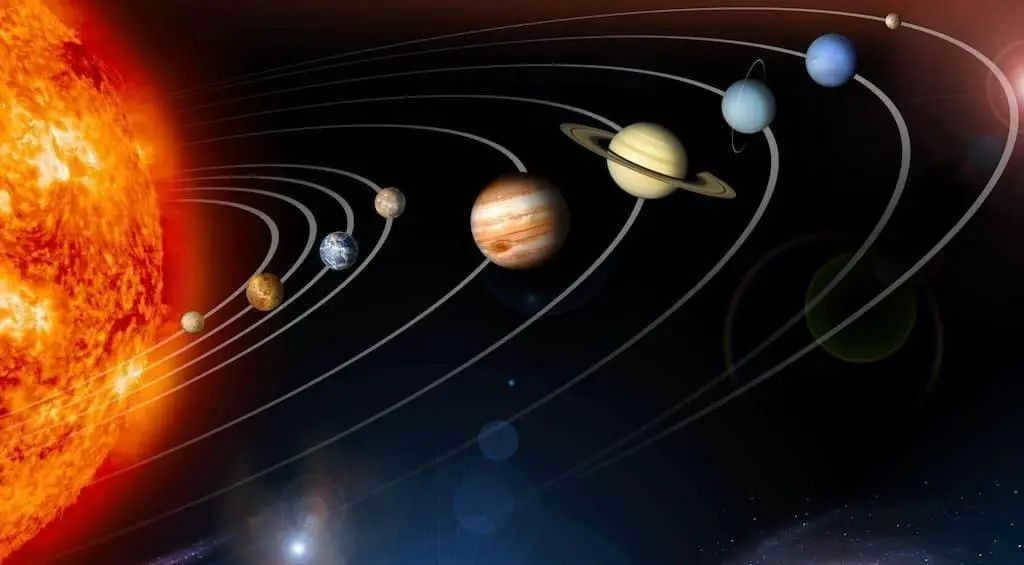
Information about the system
The solar system is a planetary system comprising of the Sun, the central star, and all other celestial bodies in heliocentric orbits. This system was created through the gravitational compression of a cloud of gas and dust approximately 4.57 billion years ago.
The solar system has a total mass of approximately 1.0014 solar masses. The majority of this mass is concentrated in the Sun, while the rest is primarily found in the eight distant planets. These planets orbit in almost perfect circles and lie within the same plane known as the ecliptic plane. This arrangement leads to a peculiar distribution of momentum within the solar system, known as the “momentum problem.” Surprisingly, only 2% of the system’s total momentum is attributed to the Sun, despite its mass being around 740 times greater than the combined mass of the planets. The remaining 98% of momentum is attributed to a mere 0.001 of the solar system’s total mass.
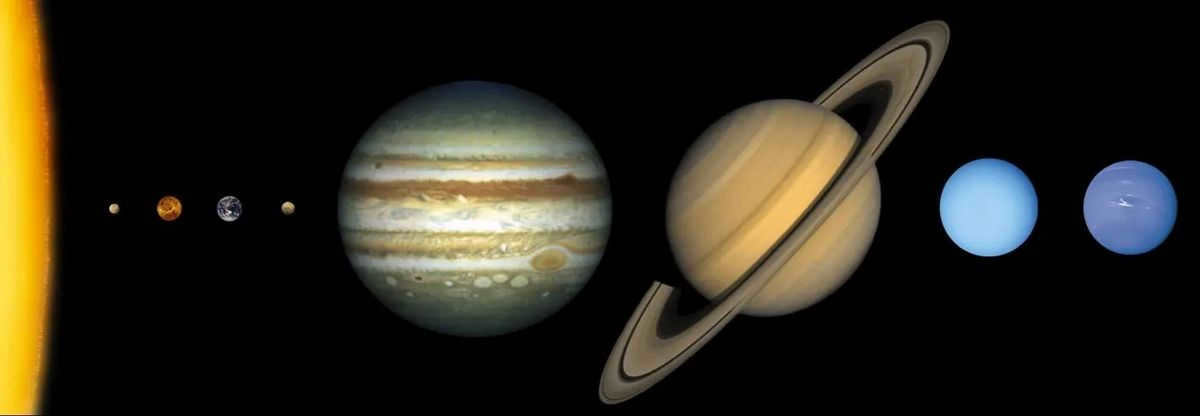

The majority of the mass in the solar system is contained within the Sun (about 99.866%). It exerts its gravitational pull to hold the planets and other celestial bodies in place. The remaining mass is mainly made up of the four gas giants, with Jupiter and Saturn being the largest contributors (accounting for approximately 90%).
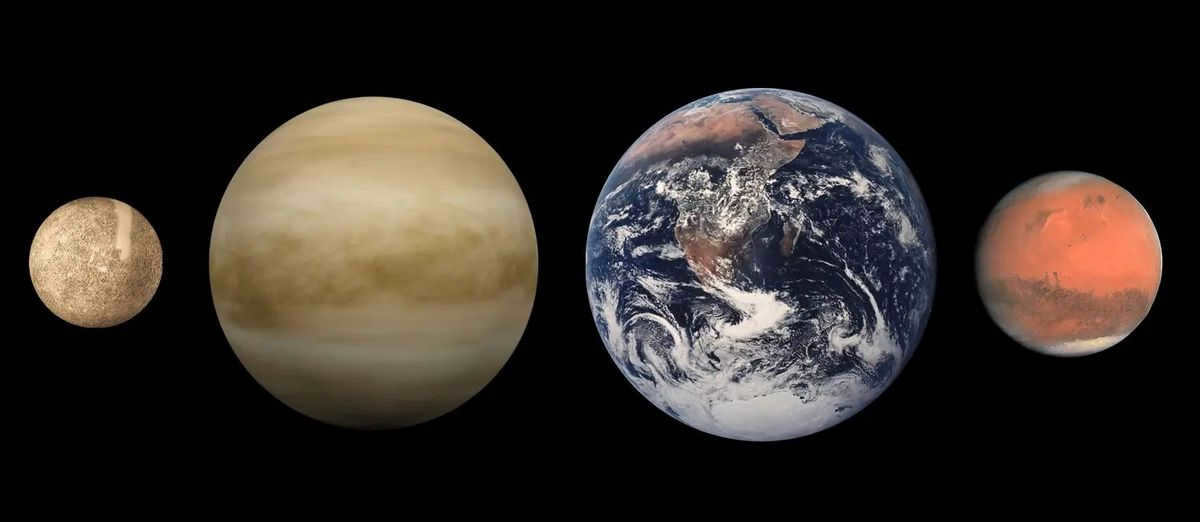
The four planets that are closest to the Sun, which are Mercury, Venus, Earth, and Mars, are mainly made up of silicates and metals.
On the other hand, the four planets that are further away from the Sun, namely Jupiter, Saturn, Uranus, and Neptune, are much larger in size compared to the terrestrial planets. Jupiter and Saturn, which are the largest planets in the solar system, are primarily composed of hydrogen and helium. Uranus and Neptune, known as the gas giants, contain not only hydrogen and helium, but also significant amounts of water, methane, and ammonia. These two planets are classified as “ice giants” due to their unique composition.
Out of the eight planets and four dwarf planets in our solar system, six have natural satellites. Additionally, Jupiter, Saturn, Uranus, and Neptune are surrounded by rings made up of dust and other particles.
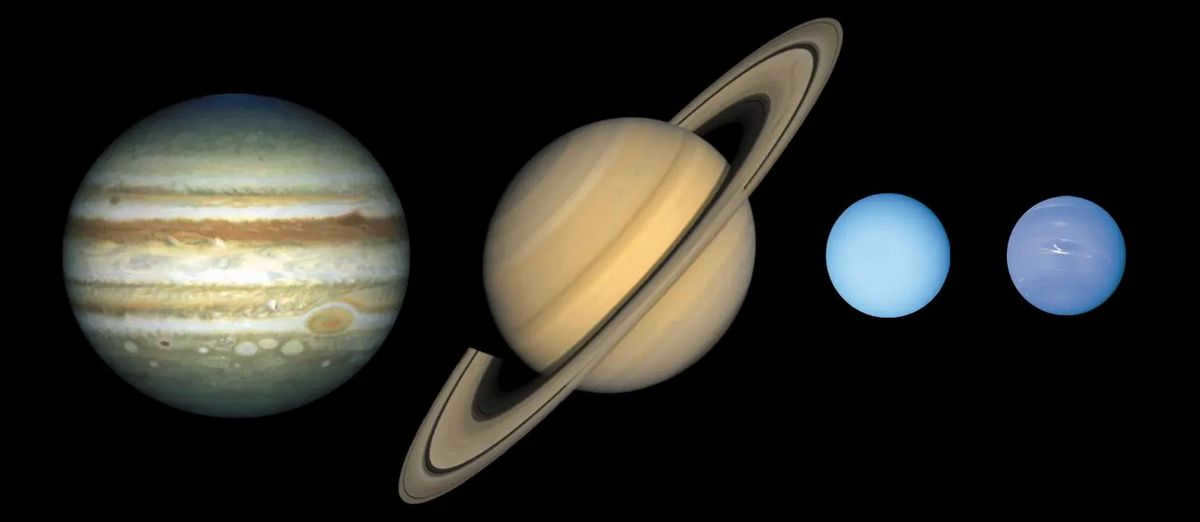
Within the solar system, there are two specific regions that contain numerous small celestial bodies. One of these regions is known as the asteroid belt, which is located between the planets Mars and Jupiter. The composition of the asteroid belt is similar to that of the terrestrial planets, as it primarily consists of silicates and metals. Notable objects within the asteroid belt include the dwarf planet Ceres, as well as the asteroids Pallada, Vesta, and Hygeia.
Additionally, there is another region beyond the orbit of Neptune that is home to trans-Neptunian objects. These objects are primarily composed of frozen water, ammonia, and methane. Some of the largest trans-Neptunian objects include Pluto, Sedna, Haumea, Makemake, Kvavar, Ork, and Erida.
Aside from these regions, there are various other populations of small celestial bodies within the solar system. These include planetary quasi-satellites and Trojans, near-Earth asteroids, centaurs, damocloids, comets, meteoroids, and cosmic dust that travel throughout the solar system.
The majority of the large objects in orbit around the Sun travel in essentially the same plane, which is known as the ecliptic plane. All planets and most other objects orbit the Sun in the same direction as the Sun’s rotation (counterclockwise when viewed from the Sun’s north pole). There are a few exceptions, such as Halley’s Comet. Mercury has the highest angular velocity – it is able to complete a full revolution around the Sun in just 88 Earth days. On the other hand, Neptune, the most distant planet, takes 165 Earth years to complete one orbit. Most of the planets also rotate on their axis in the same direction as they orbit the Sun. However, Venus and Uranus are exceptions, with Uranus having a rotation axis tilted at almost 90 degrees, making it appear to be “lying on its side.”
The solar system is a part of the structure of the Milky Way galaxy.
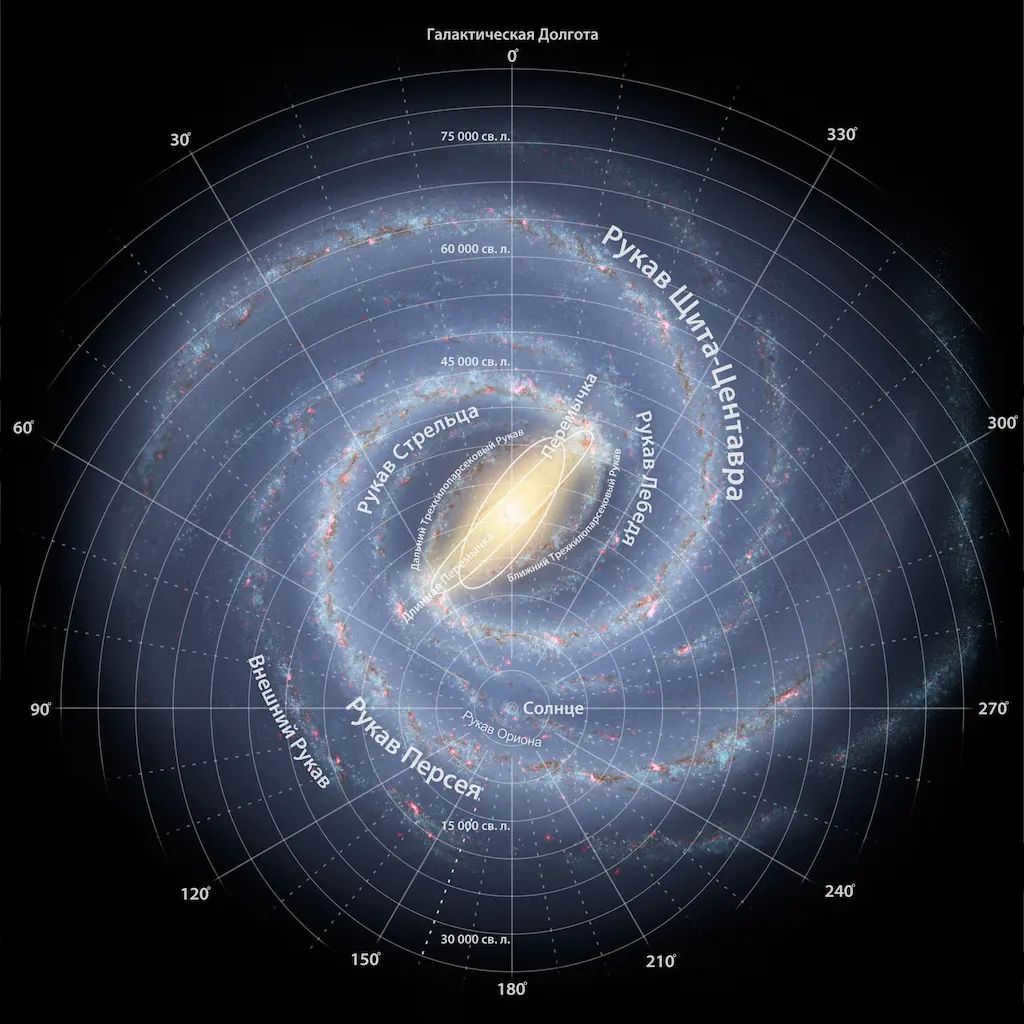
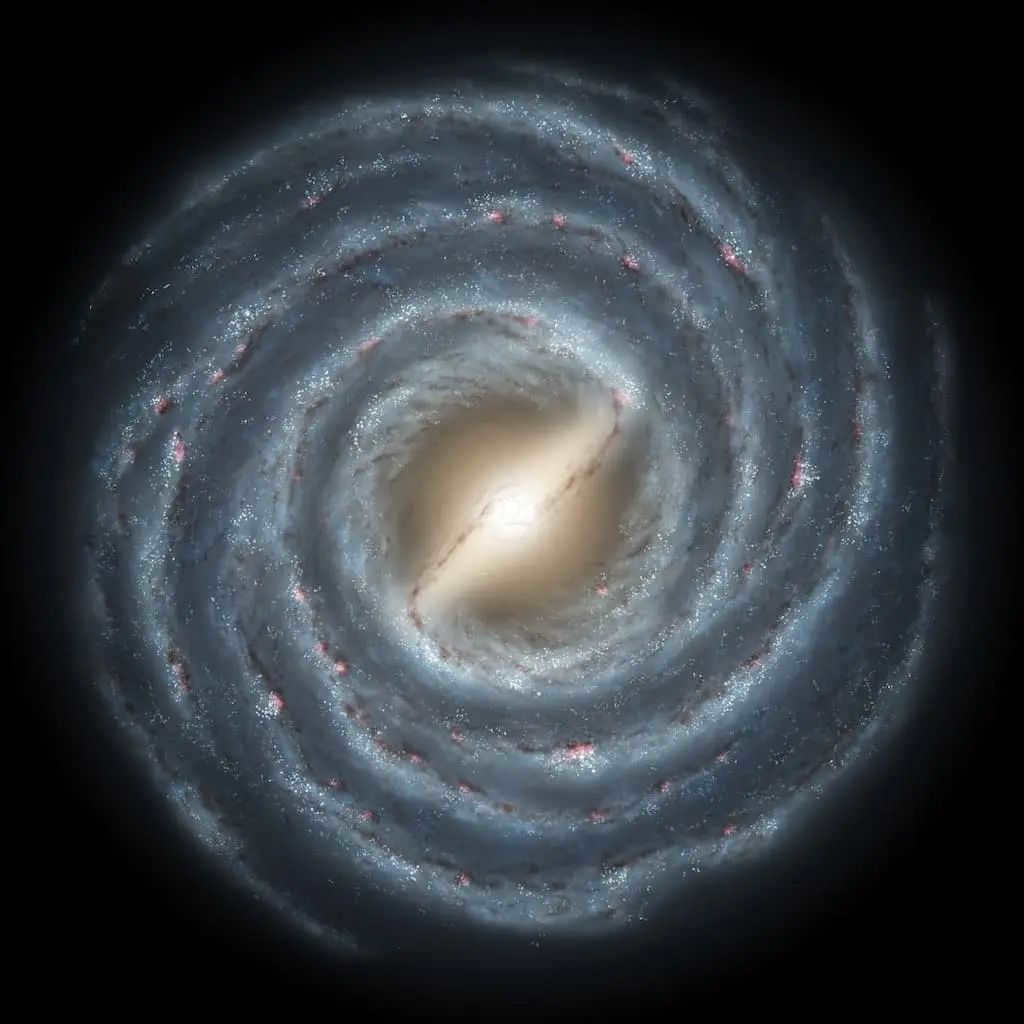
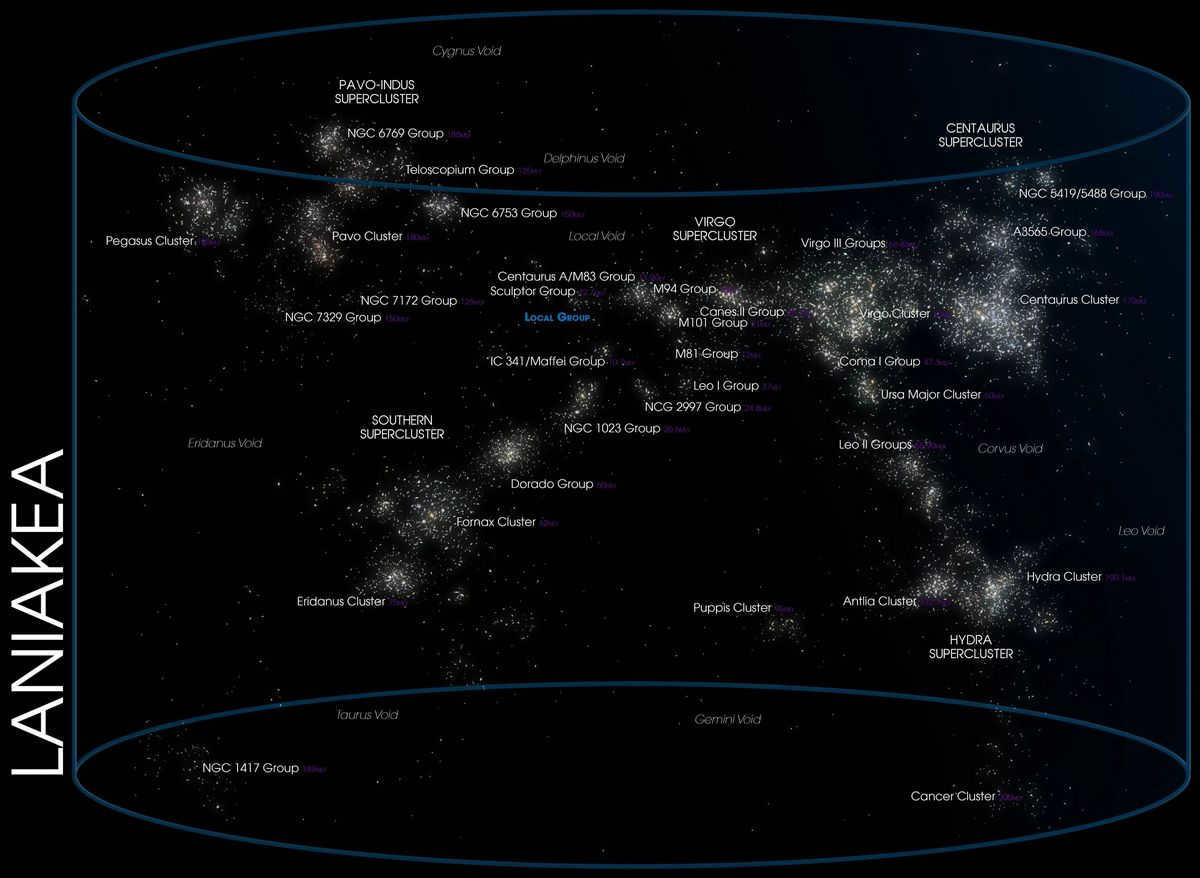
Objects
The Sun’s orbiting objects in the Solar System are officially categorized into three groups: planets, dwarf planets, and small solar system bodies. A planet is defined as any celestial body that orbits the Sun and has enough mass to become spherical, but not enough to initiate thermonuclear fusion. Additionally, a planet must have cleared the area around its orbit.
Based on this definition, there are currently eight recognized planets in the Solar System: Mercury, Venus, Earth, Mars, Jupiter, Saturn, Uranus, and Neptune. However, Pluto, which was considered a planet until 2006, does not meet this criteria as it has not cleared its orbit of the surrounding objects in the Kuiper Belt.
A celestial body that orbits the Sun and maintains a nearly spherical shape due to its own gravitational forces, but has not cleared its orbital space of planetesimals and is not a satellite of a planet, is known as a dwarf planet. There are currently five recognized dwarf planets in the solar system: Ceres, Pluto, Haumea, Makemake, and Erid.
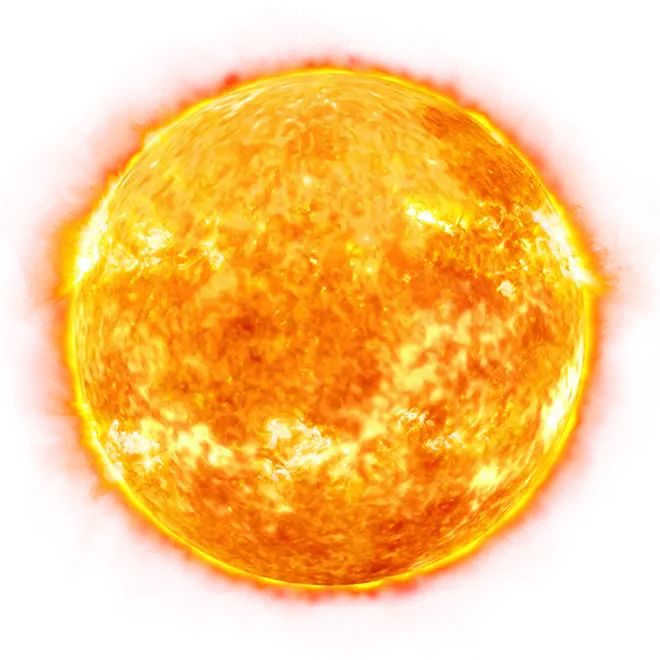
The Sun is a yellow dwarf, a sizzling sphere of luminous gases situated at the heart of our solar system. Our Sun, a star that has been around for approximately 4.5 billion years, is a scorching, radiating mass of hydrogen and helium positioned at the center of our solar system. The distance between the Sun and Earth is roughly 150 million kilometers, and the Sun’s diameter measures approximately 1,392,700 km.
The Sun, which is the largest object in our solar system, can be compared to 1.3 million Earths in terms of its volume. Its immense gravitational force plays a crucial role in keeping the solar system intact, ensuring that everything, from the largest planets to the tiniest space debris, revolves around it. The core of the Sun is the hottest region, with temperatures soaring up to a staggering 27 million degrees Fahrenheit (15 million degrees Celsius). The Sun’s dynamic activity, ranging from powerful eruptions to the constant release of charged particles, significantly impacts the space environment throughout the entire solar system. Similar to other main-sequence stars, the Sun generates energy through the process of thermonuclear fusion, wherein helium is formed by fusing hydrogen atoms together.
In early July, the Earth reaches the aphelion point and moves approximately 152 million kilometers away from the Sun. Conversely, in early January, the Earth reaches the perihelion point and approaches the Sun at a distance of around 147 million kilometers. During this period, the apparent diameter of the Sun changes by about 3%. Due to the difference in distance, which is approximately 5 million km, the Earth receives roughly 7% less heat at aphelion.
The Sun is positioned approximately 26,000 light-years away from the center of the Milky Way galaxy. It completes one revolution around the galaxy in a span of 225-250 million years. The Sun’s orbital velocity is estimated to be 217 km/s, enabling it to travel a light year in approximately 1400 Earth years and one astronomical unit in just 8 Earth days.

Space
Ranked as the second largest celestial body in our solar system, Saturn is widely recognized for its distinctive ring system. This gas giant captivates the attention of countless astronomers, offering valuable insights into the intricate makeup of the universe. With extensive research conducted on Saturn, comprehensive information about this fascinating planet is readily available to all.
Saturn is renowned for its remarkable dimensions: its equatorial diameter measures 120,536 km, while its polar diameter reaches 108,728 km. The planet’s surface area spans an impressive 4.27 * 10'10 square kilometers, and its volume is equally staggering at 8.27 * 10'14 cubic kilometers.
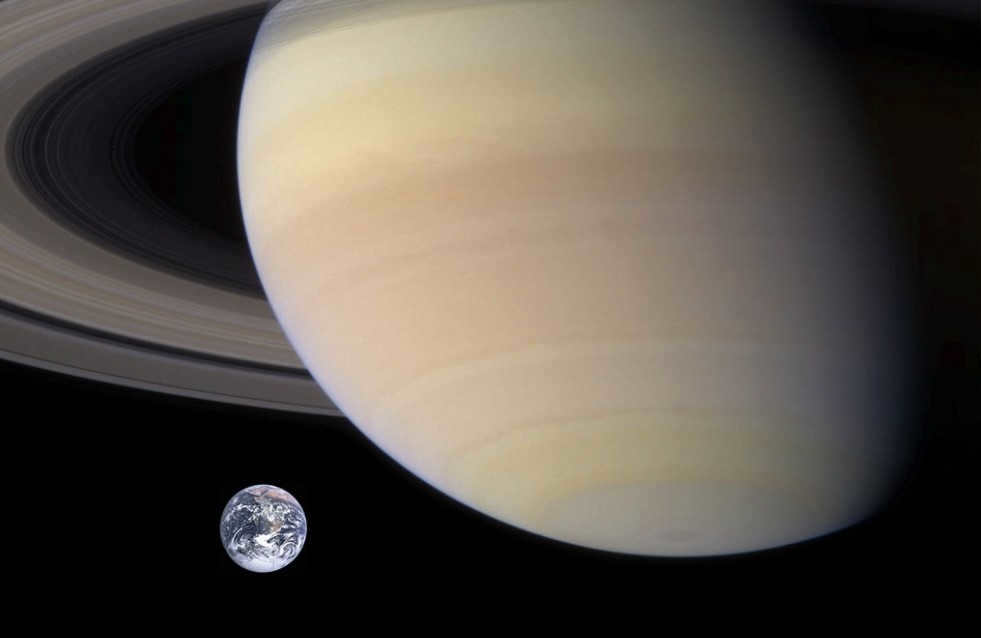
Fascinating fact: Saturn’s dimensions are significantly larger than Earth’s. Its radius is 9.3 times larger, its area is 82 times larger, its volume is 765 times larger, and its mass is 95 times larger.
The gas giant has an average distance of 1.4 billion kilometers from the Sun. Throughout its complete orbit around the star, the maximum distance increases to 1,513,783,000 km, while the minimum distance decreases to -1,353,500,000 km. Saturn’s rotational speed is 9.69 km/s, although it can vary depending on its position in space. A year on the planet lasts 10,759 days, which is 29.5 times longer than on Earth.
Composition and appearance
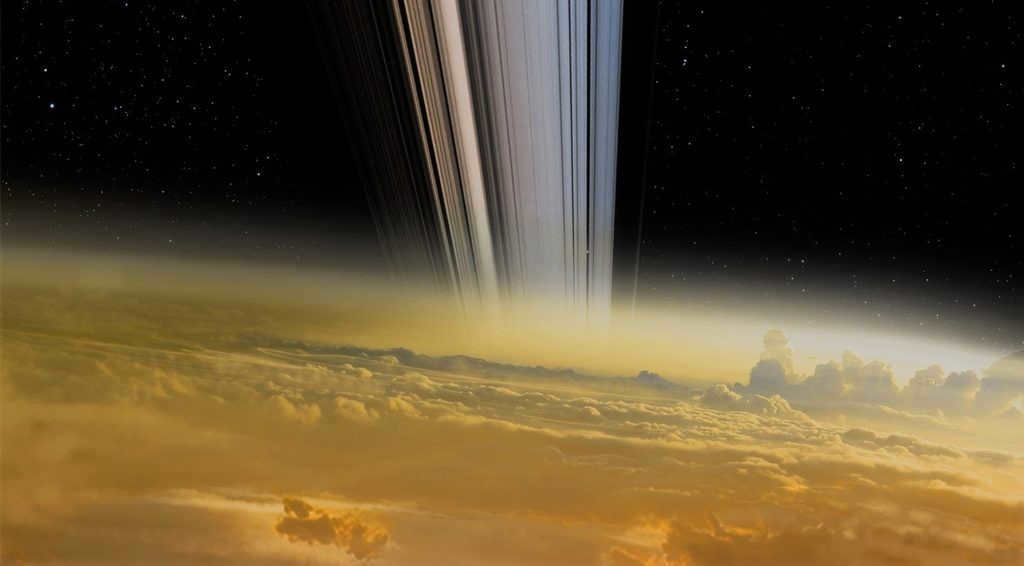

Due to its status as a gas giant, Saturn possesses a surface with a relatively low density of 0.687 g/cc. This surface primarily consists of vaporized molecular hydrogen, along with an abundance of helium.
Fascinating Fact: Given Saturn’s low density, the planet would actually float if placed in water.
Below this initial layer, there exists a cluster of liquid metallic hydrogen and helium. This mixture also contains trace amounts of volatile substances, although their exact composition has yet to be determined by scientists. At the core of Saturn lies a solid sphere with a radius of 12,500 km, featuring an uneven surface. This core is heated to a scorching 11,700 degrees Celsius and its composition may be somewhat similar to that of Earth.
The primary component in the top layer of the planet consists of hydrogen, comprising 96.3% of the total composition. Helium makes up 3.25%, while other substances make up only 0.45% of the overall volume. Scientists have discovered that within this small fraction are phosphine, ethane, acetylene, ammonia, methane, and propane.
Above the planet’s surface lies a layer of clouds, which can be further divided into upper and lower levels. The upper level is composed of ammonia crystals, while closer to the surface, there is a mixture of water and ammonium hydrosulfide. These clouds are influenced by ultraviolet rays, which initiate the process of methane photolysis. This reaction sets in motion hydrocarbon chemical reactions.
The composition of the atmosphere is characterized by widening lines as it approaches the equator. Additionally, it can be categorized into two distinct layers. The upper layer exhibits a pressure range of 0.5 to 2 bar and temperatures ranging from -173 to -113 degrees Celsius. Conversely, the lower layer experiences pressures of 10 to 20 bar and temperatures between -3 and 57 degrees Celsius. An icy cloud layer separates these two layers, where temperature and pressure undergo a gradual transition.
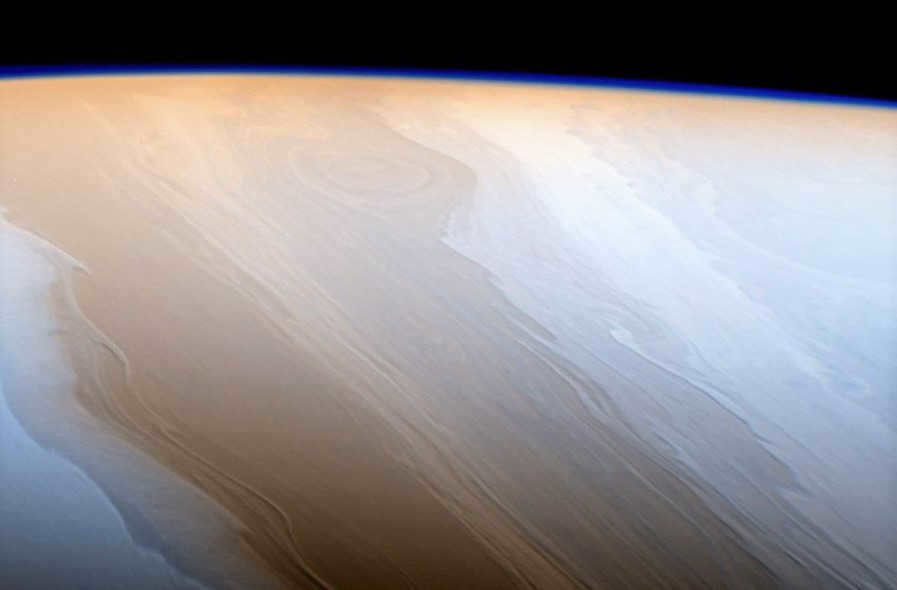

Oval spots sometimes appear in Saturn’s atmosphere, which are lighter in color than the surrounding clouds. This makes them easily distinguishable on the planet’s surface. The nature of these spots has yet to be explained by scientists, but observations have revealed a pattern in their formation. For instance, when the summer solstice begins in the northern hemisphere of the gas giant, a Great White Spot appears in that region. One theory suggests that the formation of these white spots is connected to electrostatic disturbances.
At the surface of the enormous Saturn, there are winds that can reach speeds of up to 500 m/s, making it the second fastest in the solar system after Neptune. In the planet’s northern region, there are flows with a wave-like structure, while in the south, there are flows with a jet-like structure.
Fascinating fact: Saturn experiences periodic storms that can be larger than the Earth in size.
One of the most notable vortices observed by the Hubble telescope was a wind stream in the shape of a hexagon, which spanned across the southern hemisphere. This vortex had a radius of 6,900 km and took 10 hours and 39 minutes to complete a full rotation.
The composition of Saturn
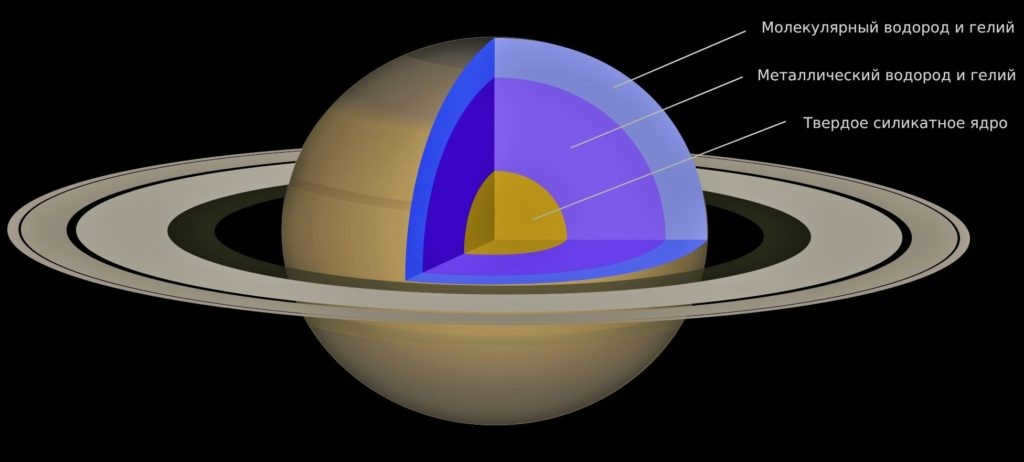
Research has provided evidence that Saturn bears a resemblance to Jupiter in terms of structure and is composed of three distinct layers. At its core, Saturn boasts a rocky composition and is estimated to possess a mass 10-20 times greater than that of Earth. Surrounding the core is a layer of liquid metallic hydrogen, which spans approximately 14,500 kilometers in thickness. The outermost layer, on the other hand, reaches depths of 18,500 km and consists predominantly of molecular hydrogen.
Throughout its complete orbit around the Sun, Saturn maintains an average distance of 1.43 billion kilometers from the star. To put things into perspective, Earth is located a mere 9.5 times closer to the Sun. Given this considerable distance, Saturn completes a full revolution in 10,756 days.
Fascinating fact: It takes approximately 1 hour and 20 minutes for sunlight to travel from the Sun to Saturn. In this span of time, the planet covers a distance of 46,500 kilometers as it orbits around the star.


Saturn is ranked third in terms of eccentricity among the planets in the solar system, with only Mars and Mercury having a higher eccentricity. This value indicates the extent to which the orbit deviates from a perfect circle. Specifically, it represents the difference between the maximum and minimum distances from the Sun. Saturn’s eccentricity is approximately 154,000,000,000 km, which is equivalent to 400 times the distance between the Earth and the Moon.
The planet has a tilt of 26.73 degrees along its axis of rotation. This tilt allows for the occurrence of seasons on Saturn. However, due to its significant distance from the Sun, the variations between the seasons are not as pronounced.
The latitudes on Saturn’s surface and atmosphere are visibly divided and also rotate at varying speeds. This disparity in rotation is due to the fact that the upper layer of Saturn is made up of gases instead of solids.
The Ringed Planet
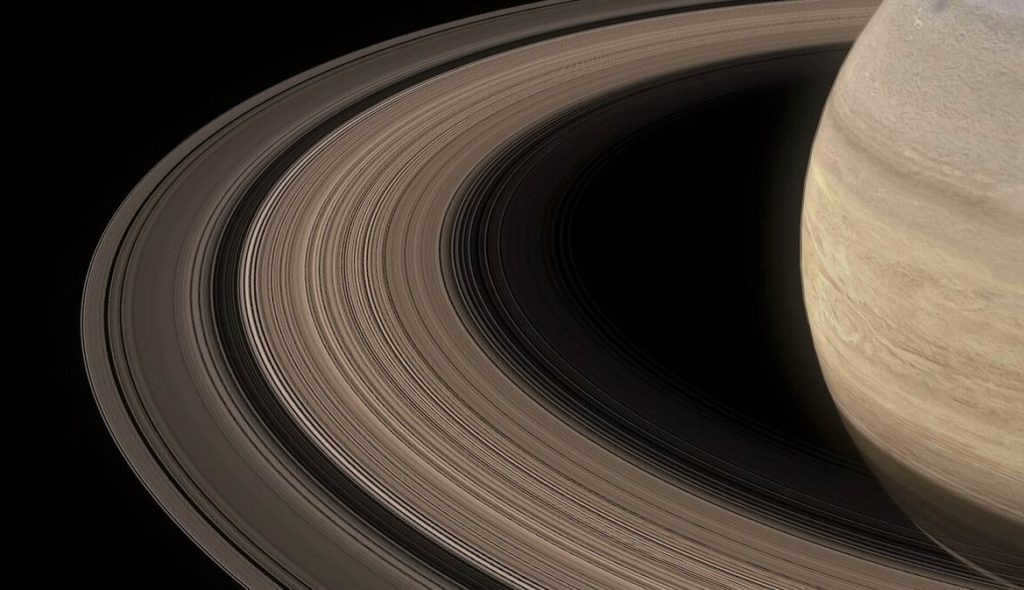

Saturn possesses the most distinctive rings out of all the planets in our solar system. These rings consist predominantly of ice particles, space debris, and dust. It is this composition that allows them to be visible even from a significant distance.
Currently, there are seven known rings encircling this gas giant. They were designated using the letters of the English alphabet in the order of their discovery: A, B, C, D, D, E, F, and G. When Saturn is observed through a telescope from Earth’s surface, only the A, B, and C rings are clearly discernible.
Research has indicated that these seven rings are actually composed of thousands of smaller rings that have fused together. However, there are gaps between these groups of rings. The largest gap exists between rings A and B, measuring 4700 km.
Did you know?The closest ring to Saturn is located 7000 km away, while the farthest ring is positioned 73,000 km away.
Despite the rings having a total span of approximately 66,000 km, their depth measures no more than one kilometer.
The Origin of the Rings
One theory regarding the origin of Saturn’s rings suggests that they formed as a result of a catastrophic event. Approximately 4 billion years ago, a satellite composed mostly of ice was orbiting the gas giant. For unknown reasons, it came dangerously close to Saturn’s surface, causing the gravitational forces to shatter it into numerous smaller fragments. These fragments, due to the influence of gravity, remained within the planet’s orbit and gradually coalesced to form the iconic rings that we observe today as Saturn rotates on its axis. It is important to note that the satellite’s close approach to the gas giant is just one possible scenario for its destruction; alternatively, it could have collided with another celestial body.
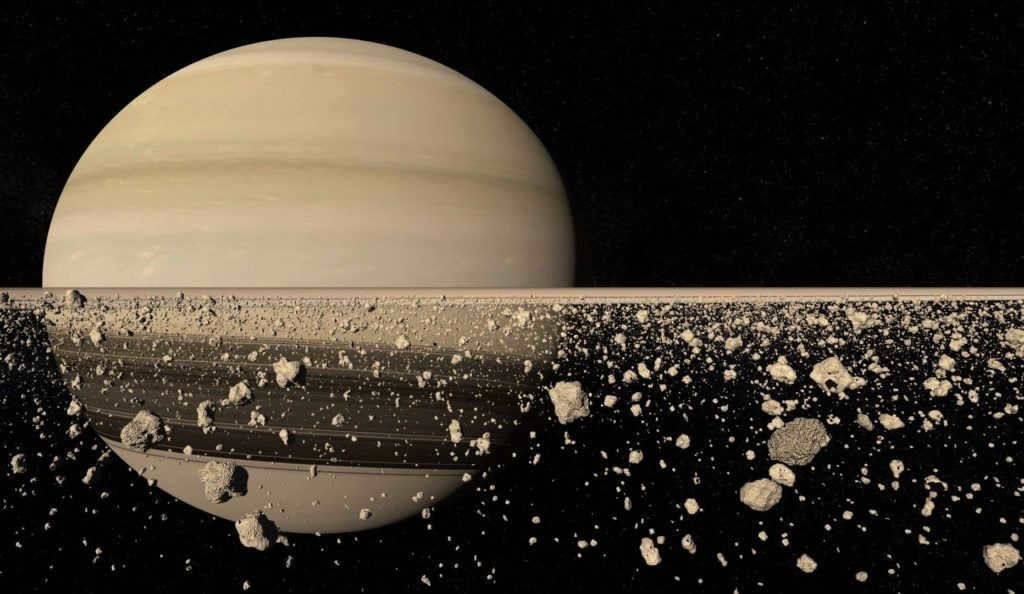
There exists an alternate theory regarding the origin of the rings, proposing that they were formed alongside Saturn during the formation of the solar nebula. However, if this were the case, the ice composing the rings would be expected to be coated with dust and other particles, yet it remains remarkably pristine. Proponents of this hypothesis maintain that the absence of foreign debris can be attributed to the frequent collisions of pebbles during the rings’ motion.
The Moons of Saturn
Saturn is orbited by a total of 62 main satellites, each with its own unique characteristics. There are also nine celestial bodies that have yet to be named. Over half of these satellites have a radius of less than 5 km, making them relatively small in size. However, there are also larger satellites in Saturn’s orbit, some of which can reach sizes of up to 5000 km.
Many of these celestial bodies are named after the ancient Greek titans, paying homage to their mythical origins. One notable group of moons is the inner moons, which are located between Saturn and its rings.
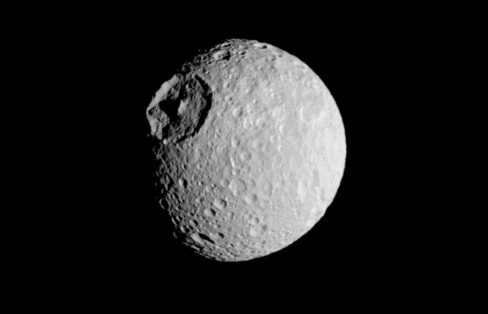
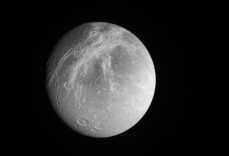
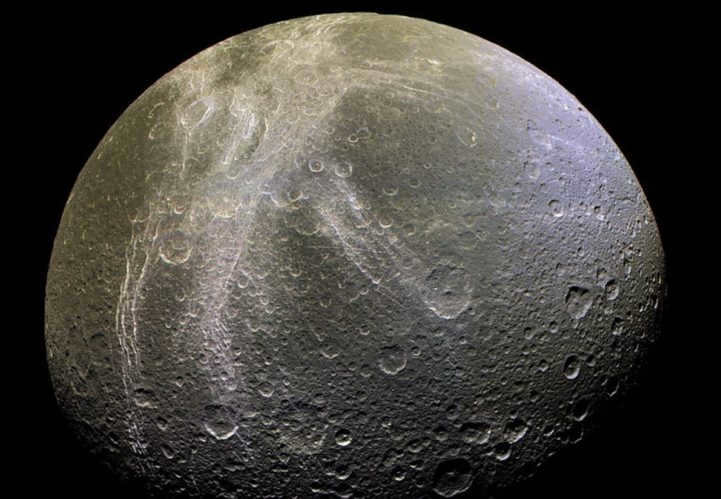
- Mimas. This satellite, which has an egg-like shape, is positioned just 185,539 km away from the planet. With a radius of 198 km and a mass of 4*10^19 kg, Mimas completes one revolution around Saturn in approximately 22 Earth hours.
- Enceladus. Known as the smallest moon in the solar system, Enceladus is a spherical satellite with a radius of 252 km and a mass of 1.1*10^20 kg. It orbits on its axis and periodically exhibits geological activity, resulting in the formation of fissures in the southern latitudes and the emergence of geysers. The upward ejection of water provides evidence of the presence of an internal ocean, where the possibility of life exists.
- Tefia. With a radius of 533 kilometers, this moon is characterized by its surface, which consists of craters and plains.
- Dione is considered to be the largest inner moon of Saturn. It has a radius of 556 km and a mass of 1.1*10^21 kg. The presence of numerous craters on its surface suggests that it is extremely old.
All inner moons are primarily made up of ice, although they may also have a solid rocky core.
The outer satellites are situated beyond the E ring. They are predominantly composed of rock and ice. The following significant moons can be identified among them:
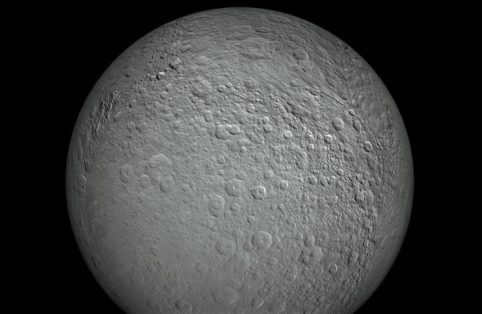
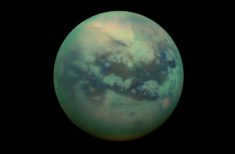
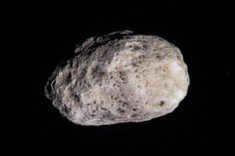
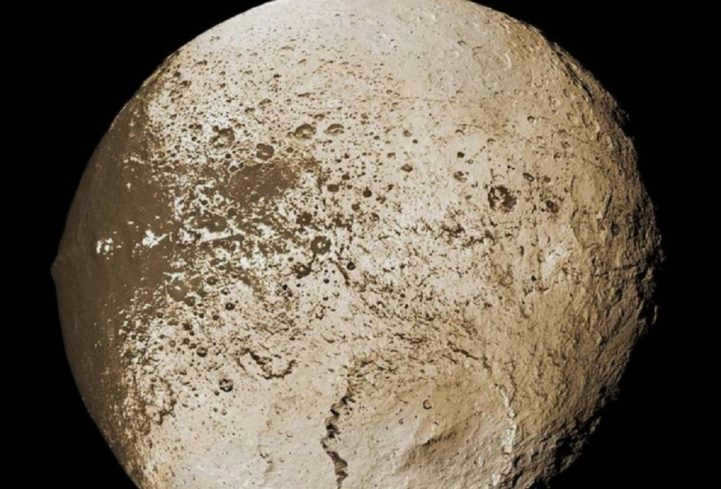
- Rhea. With a radius of 764 km and a mass of 23*10'20 kg, Rhea is a satellite located 527,108 km away from the planet. It takes four and a half Earth days for Rhea to complete a full revolution. The surface of the satellite is adorned with numerous craters.
- Titan. Titan, the largest celestial body orbiting the planet, has a radius of 2575 km and a mass of 1.35*10'20 kg. Its atmosphere is composed of methane and nitrogen, creating an opaque fog that envelops the satellite. Craters and plains can only be seen in certain areas on the surface. Titan is situated at a distance of 1,222,000 kilometers from the gas giant and takes 16 days to complete a full revolution.
- Hyperion is situated in close proximity to Titan, boasting a radius of 135 kilometers. This celestial body exhibits an egg-like shape and is characterized by its brown hue.
- Japet is positioned at a considerable distance from Saturn, specifically 3,561,000 kilometers away. As a result, it undergoes a complete revolution every 80 days.
Fascinating trivia: Saturn’s larger celestial objects possess their own satellites, such as Calypso and Telesto, which orbit around Tefia.
What is the number of satellites orbiting Saturn?
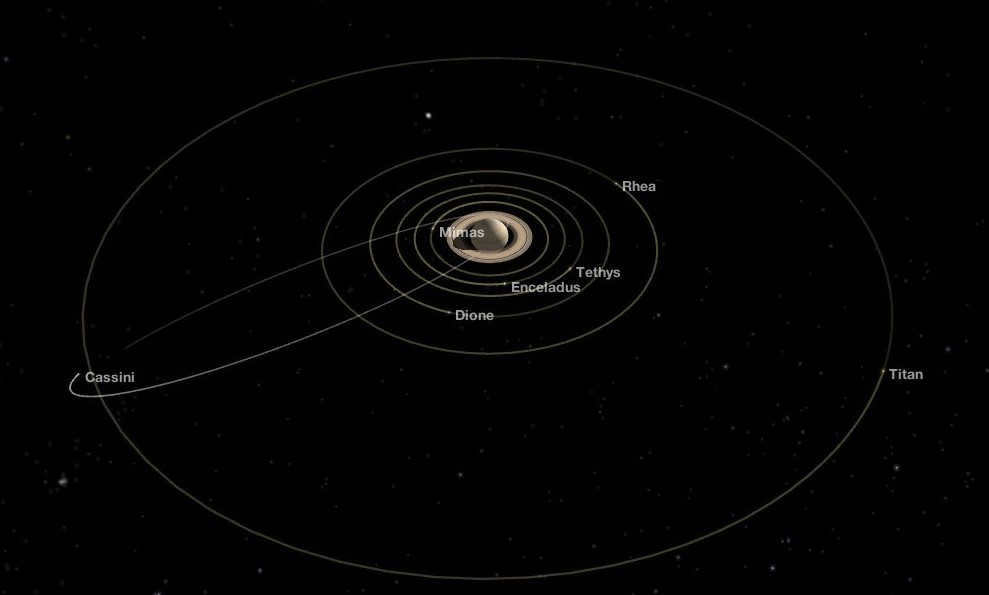
Research indicates that Saturn potentially possesses around 150 moons, although only 62 of these follow regular orbital paths. The remaining moons are situated at significant distances from the planet and exhibit irregular orbits. These irregular satellites require several years to complete a full revolution around the gas giant.
Saturn, being visible to the naked eye, was observed by ancient civilizations, leading to its discovery. Babylonian records contain references to this planet, while the Greeks referred to it as Kronos, after the deity associated with farming. Additionally, Ptolemy successfully computed Saturn’s orbital path.


In 1610, Galileo was the first person to observe Saturn through a telescope and he mistakenly thought that the rings were satellites. Later on, Christian Huygens discovered Titan and a few other celestial bodies that orbit around Saturn. Throughout the 20th century, astronomers continued to make new discoveries of satellites orbiting Saturn.
Did you know? Christian Huygens was the first to discover Saturn’s rings in 1655 and provide a description of them.
When the conquest of space began, numerous spacecraft were dispatched to Saturn. The planet was photographed by the Pioneer 11 probe in 1979. Voyager 1 reached Saturn in 1980, and was followed a year later by Voyager 2. In 2004, the Cassini spacecraft commenced gathering data on Saturn and its moon Titan, and in 2006 it made the remarkable discovery of a previously unknown ring. Presently, the gas giant is being regularly observed through state-of-the-art telescopes.
What is the year of Saturn’s discovery?
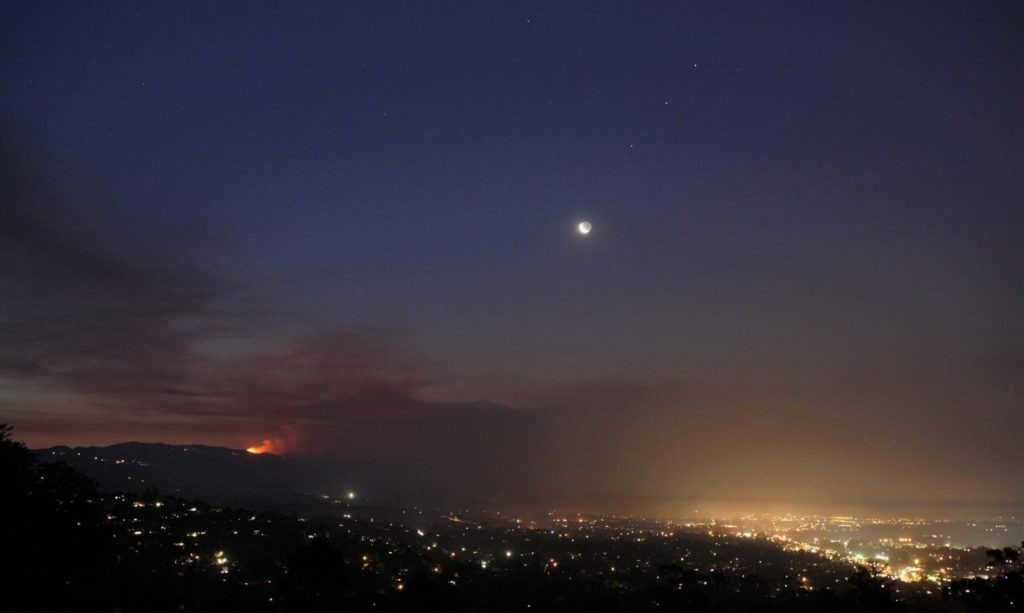
Saturn was first observed by humans in ancient times. It is one of the five planets that can be spotted in the sky without any optical aids. This gas giant was familiar to the ancient civilizations of Greece, Rome, and Babylon.
Who made the discovery?
Although people in ancient times saw Saturn in the sky, the credit for its official discovery goes to Galileo Galilei. Using his self-invented telescope, he observed the planet up close and personal.
In ancient Greece, the planet was named Kronos, after the god of agriculture. The Romans adopted this name and called the celestial body Saturn, after their god of harvest. Ever since then, this gas giant has been known by that name.
Origin of Saturn
Saturn, similar to the rest of the planets in our solar system, emerged approximately 4.6 billion years ago. The presence of hydrogen and helium in its composition suggests that this gas giant was created from a nebula. Initially, during the first 600 million years, Saturn did not possess any rings. Scientific research has revealed that these rings are not more than 4 billion years old.
The formation of Saturn

Originally, instead of the solar system, there existed a vast cloud of dust and gas. At a certain point in time, an external force came into play, whether it was a wave resulting from a supernova explosion or a collision with another cloud.
As a result, the cluster commenced its rotation and gradually began to contract. The energy accumulated at the core triggered the emergence of a protostar, which eventually matured into our Sun. The remaining dust and gas started to orbit around the star, forming a disk. The more solid materials were found closer to the center, eventually giving rise to the planets of the Earth group.
In the distant reaches, icy particles and gases dispersed, eventually giving rise to the gas giants, such as Saturn.
It is highly unlikely for life to exist on Saturn due to its inhospitable conditions. The planet’s upper layer primarily consists of gas, making it impossible for any form of life to settle on its surface. Furthermore, temperatures on Saturn can plummet to as low as -150 degrees Celsius.
If one were to venture towards the core of the planet, where the climate is relatively warmer, the pressure would start to intensify. At depths where the temperature starts to rise, the pressure is comparable to that found at the depths of Earth’s oceans.
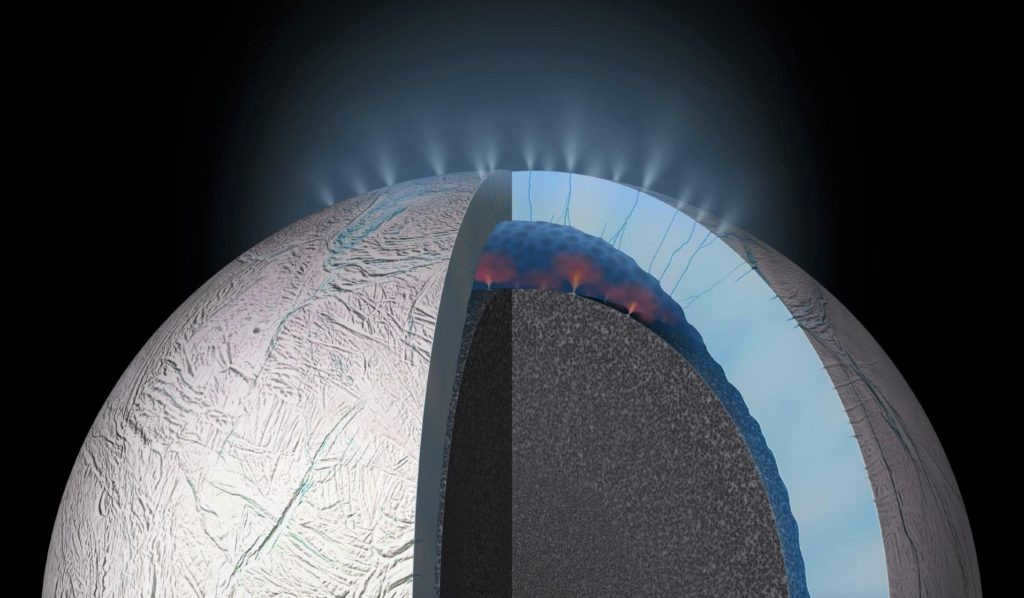
Nevertheless, Saturn’s moons might harbor life. One such moon, Titan, possesses hydrocarbon seas that could potentially support protozoan organisms.
Observing Saturn in the night sky can be made much easier with the help of a telescope, as it allows for a larger and clearer view of the planet. Even amateur equipment can provide a fairly impressive picture of the gas giant. To locate Saturn, one should look towards the southern part of the sky.
Fascinating fact: The rings of Saturn, which reflect light, contribute to the planet’s overall visible area, making it easier to spot.
When observing Saturn with a telescope that has a 60-70 mm aperture, one can expect to see the rings and the general outline of the planet. It may also be possible to discern the different colors of Saturn’s latitudes. For more detailed observations, a telescope with an aperture of at least 100 mm is recommended.
Using light filters can be beneficial. The color blue can enhance the visibility of the rings, green can provide more detailed views of the poles, and orange can improve the observation of Saturn’s center.
What is the duration of the journey to Saturn?
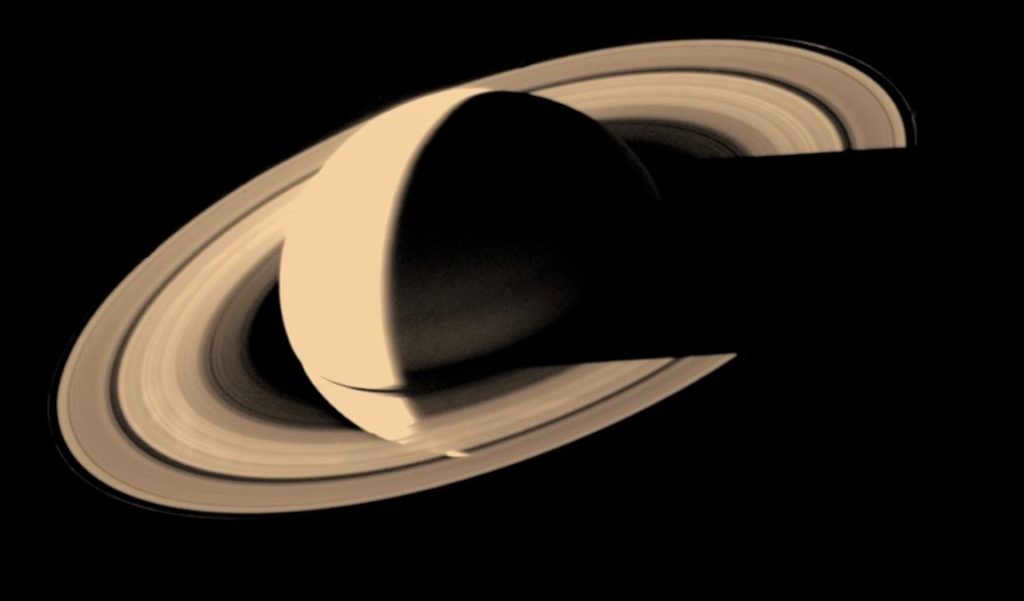
The duration of the journey from Earth to Saturn varies depending on the spacecraft used and the route taken. For example, the Pioneer 11 probe took approximately 6.5 years to reach Saturn, while Voyager 1 completed the distance in just 3 years and 2 months. Similarly, Voyager 2 reached the giant planet in approximately 4 years, and the Cassini spacecraft took 6 years and 9 months. The most recent spacecraft to approach Saturn was New Horizons, which completed the journey in 2 years and 4 months.
The significant difference in travel time can be attributed to variations in spacecraft design and the specific routes chosen for each mission.
Fascinating video on Saturn
If you come across any errors, kindly highlight the text and press Ctrl+Enter.
Every celestial body in space has its specific position, and it isn’t a result of chance. Billions of particles come together over billions of years to form a single entity, allowing us to witness various phenomena in the night sky. The planets of the solar system, listed in order from the Sun, are Mercury, Venus, Earth, Mars, Jupiter, Saturn, Uranus, and Neptune.
Knowing the sequence and structure of the nearest cosmic objects not only showcases a person’s knowledge, but also expands our understanding of the world around us, which directly impacts each individual.
- Characteristics of the system
- Arrangement of the solar system’s planets
- The Sun
- Mercury
- Venus
- Earth
- Mars
- Jupiter
- Saturn
- Uranus
- Neptune
System Characteristics
Nature, which consists of objects from distant space, is a complex mechanism, where each element is closely connected to other objects.
The solar system comprises a group of objects revolving around one star – the Sun. It is part of the Milky Way galaxy.
- The estimated age of the system is approximately 4,570,000,000 years.
- The total mass of all system elements is about 1.0014 solar masses (M☉).
- The combined mass of the planets is 2% of the system’s total mass.
- The composition of Mercury, Venus, Earth, and Mars, which are the four closest objects to the sun, consists mainly of silicates and metals. On the other hand, Jupiter, Saturn, Uranus, and Neptune, which are further away, are primarily composed of hydrogen, with traces of methane and carbon monoxide.
- Out of the eight objects mentioned, six have one or more satellites orbiting around them.
Note! Besides the planets, the solar system also includes numerous small bodies.
The diagram illustrates the structure of the solar system.
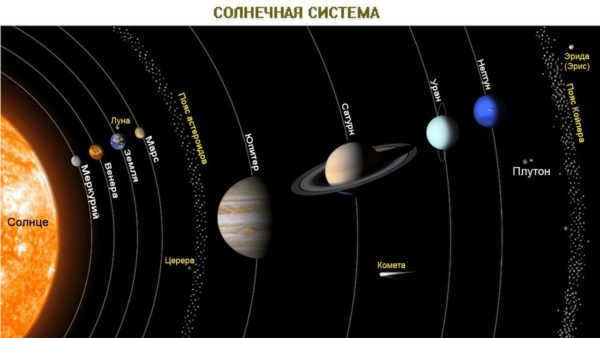
Arrangement of planets within the solar system
Following the identification of significant celestial bodies within the Kuiper belt area in 2006, a decision was made to exclude Pluto from the official list of planets. Alongside Erida, Haumea, and Makemake, Pluto was reclassified as a dwarf planet.
Interesting video: everything you should be aware of about the solar system!
The solar system’s planets
The field of astronomy is constantly progressing. With advancements in physics and technological innovations, the precision of exploring different celestial objects from a distance is improving. What was once only found in sci-fi novels is gradually becoming a tangible reality. Let’s explore each planet in the solar system in sequential order.
Star
A star is a celestial object that emits light and heat, and the Sun is the central element of our planetary system.
- The Sun belongs to the category of yellow dwarfs of class G2;
- It is also the center of our planetary system;
- As a type 1 star of the stellar population, formed late in the formation of the Universe, the Sun is characterized by a significant content of heavy elements (elements heavier than He and H);
- There are currently several stars known that are similar to the Sun in structure, age, and composition.
Isn’t it fascinating? A brief summary of the main points of Niels Bohr’s quantum postulates
The Hertzsprung-Russell diagram visualizes the variation in brightness, surface temperature, and size of stars.
Take a look at the photo of the Hertzsprung-Russell diagram.
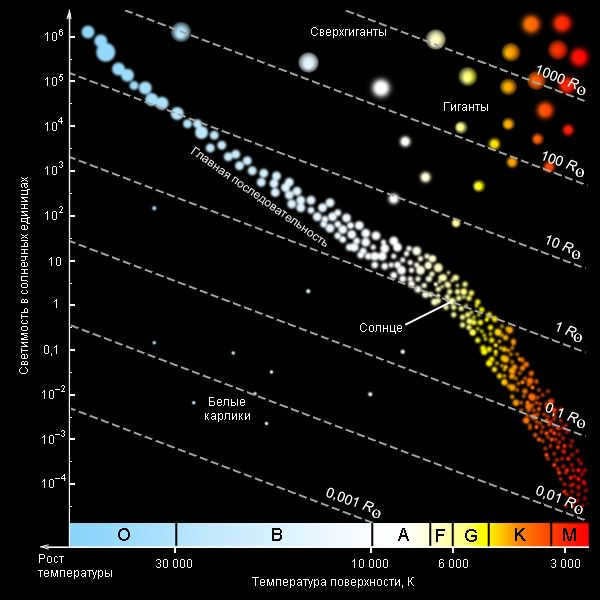
Approximately 85% of the stars we know are not as luminous and do not emit as much heat as our Sun.
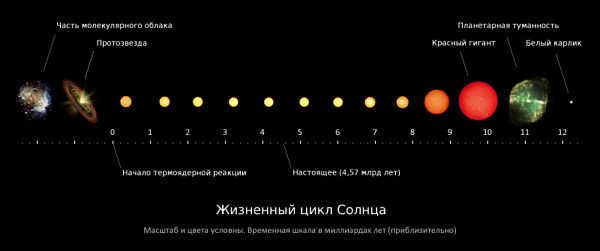
It should be noted that the Sun is currently in the middle of its development and has not yet depleted its supply of hydrogen.
The inner region of our solar system
This part of the cosmic mechanism is home to the group of planets known as the Earth group.
- These planets have smaller diameters compared to the Sun and gas giants.
- They have a high-density structure, with hard surfaces and a variety of elements in their composition.
- With the exception of Mercury, they all have atmospheres.
- They have similar structures, including a core, mantle, and crust (except Mercury).
- They also have distinct surface features.
- Most of them have no or only a small number of satellites.
- They have relatively weak gravity.
It is important to remember that each planet in our solar system is unique and fascinating in its own way.
The photo reveals the internal arrangement.

Mercury
Mercury is the closest planet to the Sun in our solar system.
- Mercury completes an orbit around the Sun in just 88 Earth days;
- One day on Mercury is equivalent to 59 Earth days;
- The average temperature during the day on Mercury is a scorching +430 degrees Celsius, while at night it drops to a freezing -170 degrees Celsius;
- Mercury has no moons or rings;
- The surface of Mercury is covered with impact craters and large ridges;
- Mercury has a very thin atmosphere.
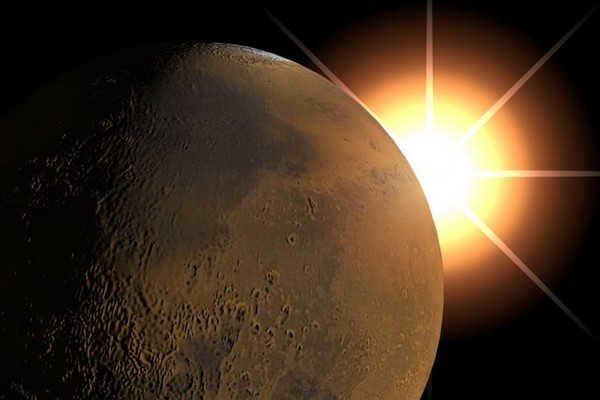
Venus
Venus, the second planet from the Sun, possesses a similar composition to our own Earth, consisting of a lithosphere, mantle, and core.
- It exhibits signs of internal activity;
- boasts an atmospheric density that is 90 times denser than Earth’s;
- contains a small quantity of surface water;
- experiences surface temperatures exceeding +400 degrees Celsius;
- has a day length equivalent to 243.02 Earth days;
- rotates in the opposite direction to the majority of celestial bodies;
- lacks any natural satellites.
Although Venus lacks a magnetic field, the presence of a thick atmosphere prevents the depletion of the planet.
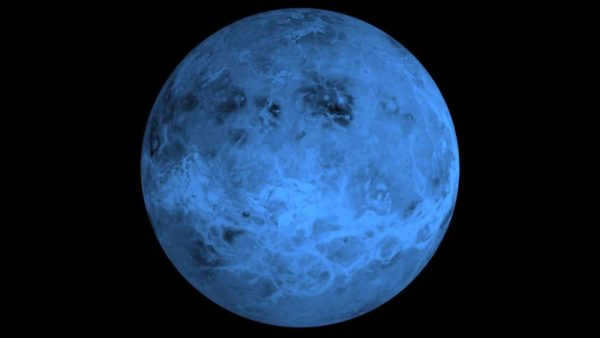

Earth
Earth is the third planet from the sun and our place of residence. A unique aspect is the abundance of diverse organisms.
- formation of the atmosphere, the hydrosphere, and the lithosphere;
- over 70% of the Earth’s surface is covered by water;
- the magnetic field is notably strong;
- 1 complete rotation takes 24 hours, while 1 orbit around the sun takes 365 days;
- presence of dynamic tectonic plates;
- a natural satellite – the Moon;
- numerous characteristics of celestial bodies (mass, rotation period, surface area) are measured relative to the corresponding values of our planet.
The existence of life on other celestial bodies remains largely unknown.
Mars
Mars, the fourth planet from the Sun, is considerably smaller than Earth or Venus.
- It takes Mars 687 Earth days to complete one revolution around the Sun;
- Mars has its own atmosphere;
- There are traces of water and ice caps at the poles of Mars;
- The atmospheric pressure on Mars is 6.1 mbar, which is only 0.6% of Earth’s pressure;
- Volcanoes have been discovered on the surface of Mars, with the tallest one, Olympus Mons, reaching a height of 21.2 km;
- There have been signs of geologic activity on Mars;
- Mars has two satellites, Deimos and Phobos.
Mars is the second most extensively studied celestial body in our solar system, following Earth.
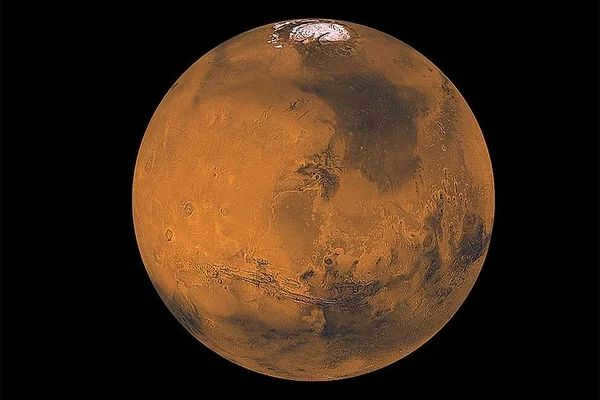
Large Gas Planets
The outer region of the planetary system is home to the large gas planets, along with their moons, the Kuiper belt, the diffuse disk, and the Oort clouds.
Characteristics of the gas giants:
- They are known for their massive size and weight.
- These planets lack a solid surface and are made up of gaseous substances.
- Their cores are composed of liquefied metallic hydrogen.
- They have a high rotational velocity.
- They possess a strong gravitational field.
- They have a large number of moons.
- Gas giants also feature rings around them.
Gas giants possess distinct characteristics that set them apart from other planets in our solar system, making it challenging to fathom the existence of life on them. Nonetheless, their influence can be felt, even here on Earth. A prime example is Jupiter’s gravitational field, which exerts a powerful pull on numerous celestial objects. If any of these were to collide with our planet’s surface, the consequences could be catastrophic on an unprecedented scale.
An illustration depicting the inner structure is displayed below.
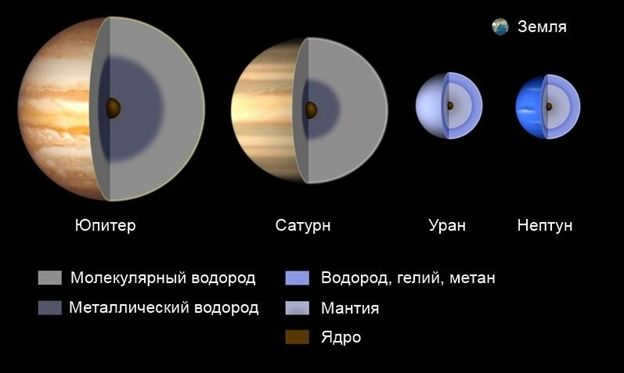
Jupiter
Jupiter is the first gas giant and the fifth planet from the Sun.
- It is primarily composed of hydrogen and helium;
- Scientists have detected a high internal temperature within the planet;
- Its orbital period around the Sun is approximately 4333 Earth days;
- Jupiter rotates on its axis every 10 Earth hours;
- The largest moons of Jupiter – Ganymede, Callisto, Io, and Europa – have a structure similar to that of Earth’s moon;
- Ganymede, the largest moon of Jupiter with a radius of 2634 km, is even larger than the planet Mercury.
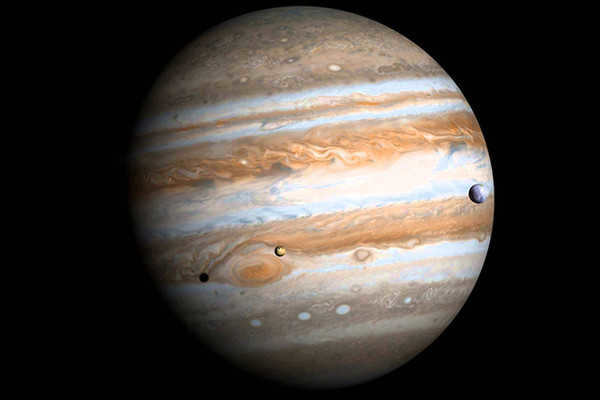
Saturn
Saturn is the sixth planet from the sun and the second largest gas giant in our solar system. One of its most distinguishing features is the presence of its highly visible rings, which can be seen from a great distance.
- It takes Saturn about 10,759 Earth days to complete one orbit around the sun.
- A day on Saturn lasts about 10.5 Earth hours.
- With a density that is lower than that of any other planet in the solar system, Saturn is known for being the least dense celestial body.
- Two of Saturn’s moons, Titan and Enceladus, exhibit geological activity.
- Titan, one of Saturn’s moons, has its own atmosphere and is even larger than the planet Mercury.
While Saturn’s rings were once thought to be a unique phenomenon, it has been discovered that all gas giants in our solar system, including one of Saturn’s moons called Rhea, have their own set of rings.
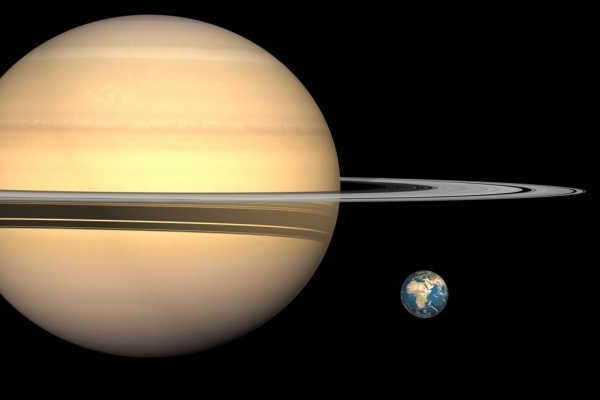
Uranus
Uranus is the lightest of the gas giants and the seventh planet from our host star.
- It has an average temperature of -224 degrees Celsius;
- Its axis is tilted at an angle of 98 degrees;
- It takes approximately 30,685 Earth days to complete one orbit around its star;
- It takes around 17 Earth hours to complete one rotation around its axis;
- The largest moons of Uranus are Titania, Oberon, Umbriel, Ariel, and Miranda.
Interesting fact! Due to its unique tilt, Uranus appears to be rolling on its side.
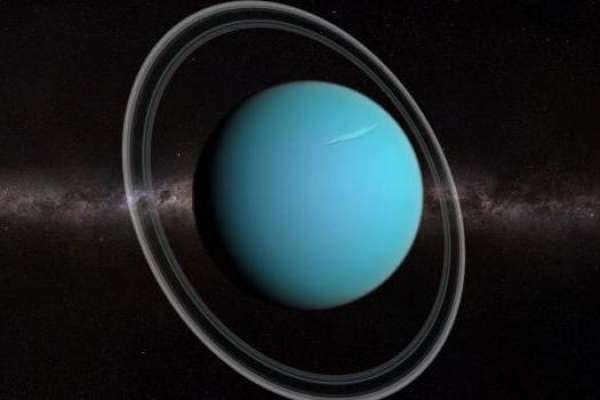
Neptune
Neptune is the eighth and final planet in our solar system.
Here are some interesting facts about this celestial body:
- It takes Neptune 60,190 Earth days to complete one orbit around the Sun.
- The wind speeds on Neptune can reach up to 260 meters per second.
- Neptune’s largest moon, Triton, is known for its geological activity and geysers of liquid nitrogen and atmosphere.
- Triton is unique among Neptune’s moons because it rotates in the opposite direction compared to the other satellites.
What makes Neptune truly remarkable is that its existence was first deduced through mathematical calculations. Unlike the other planets in our solar system, which were discovered using telescopes, Neptune’s presence was predicted based on its gravitational influence on the other planets.





